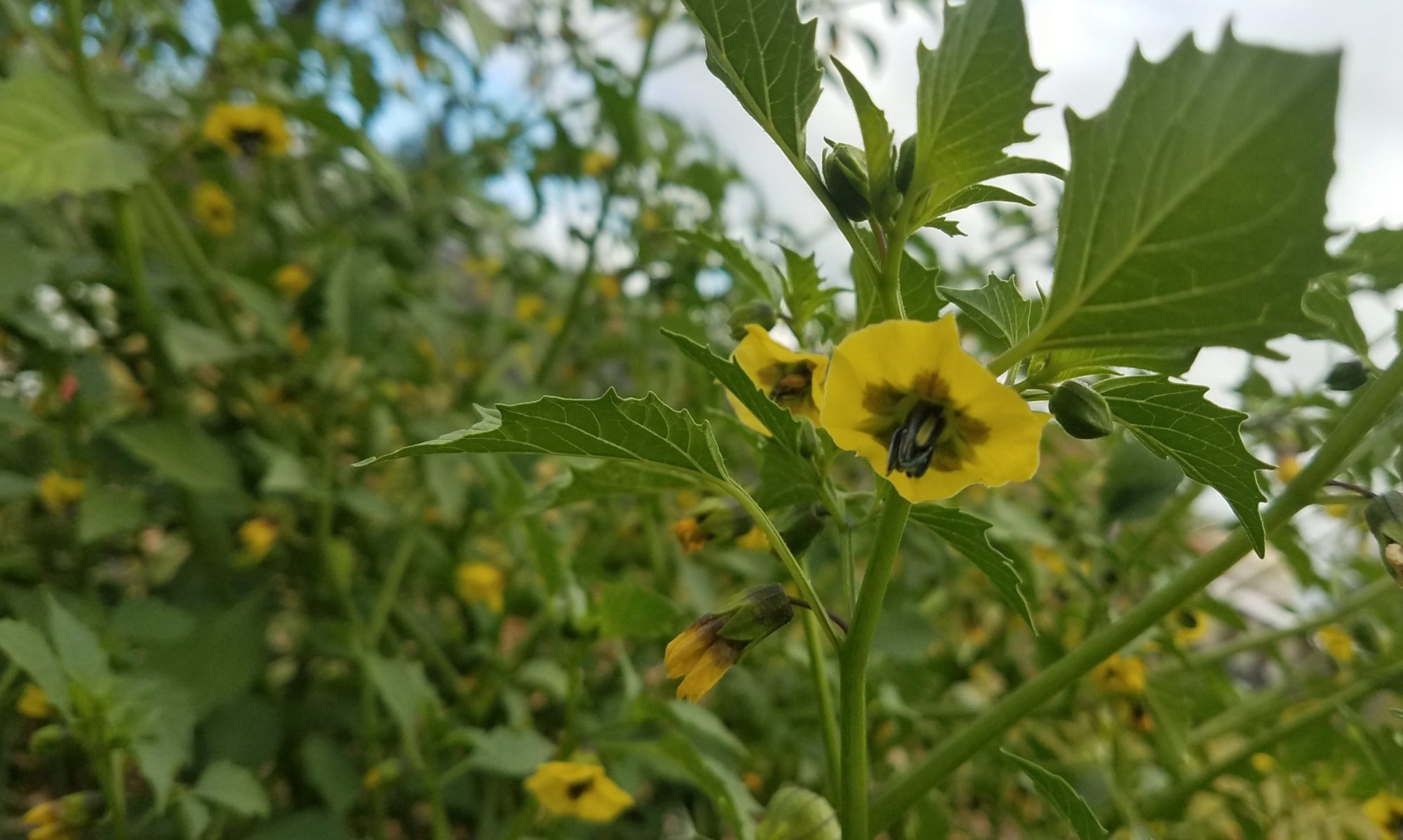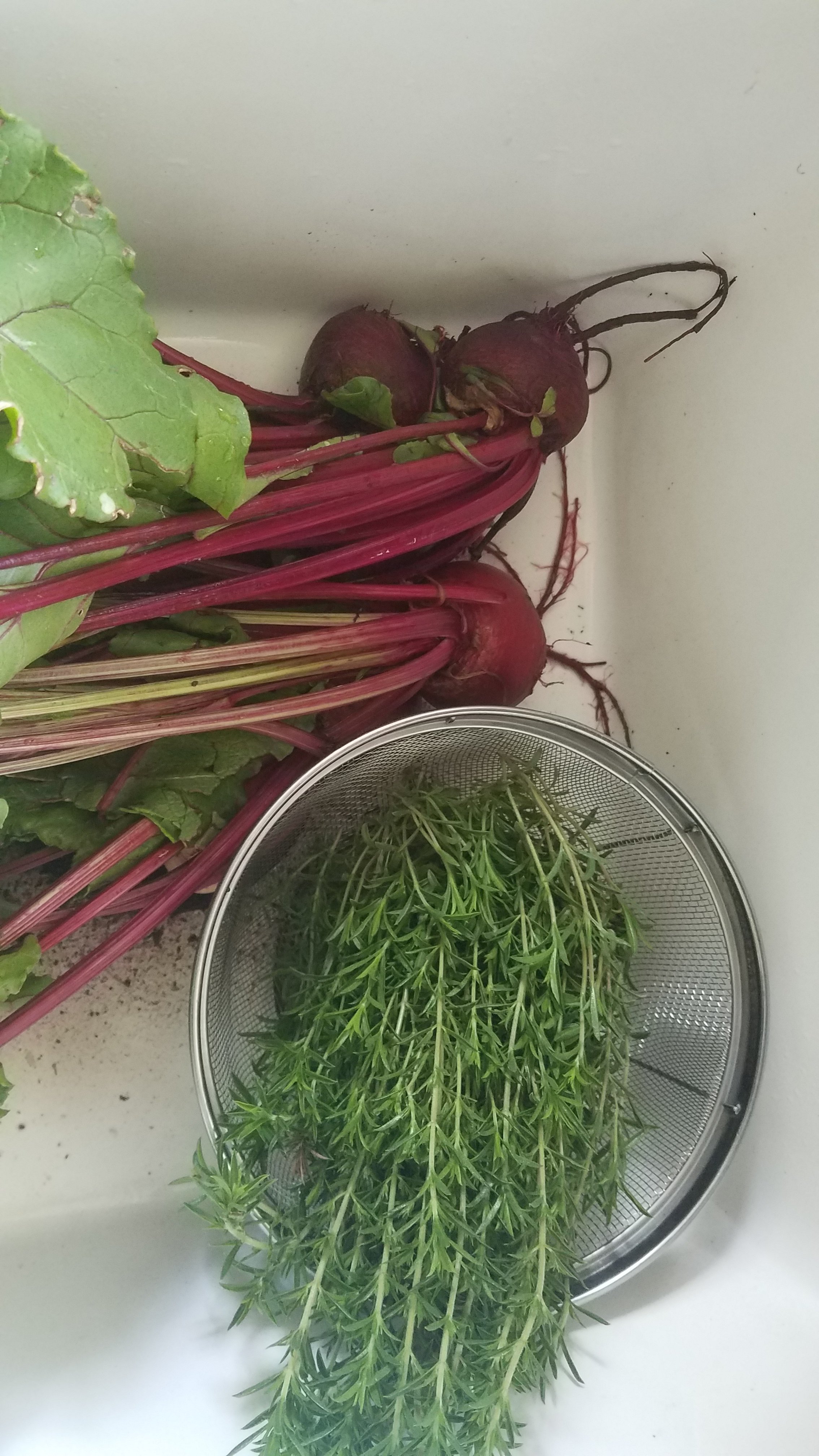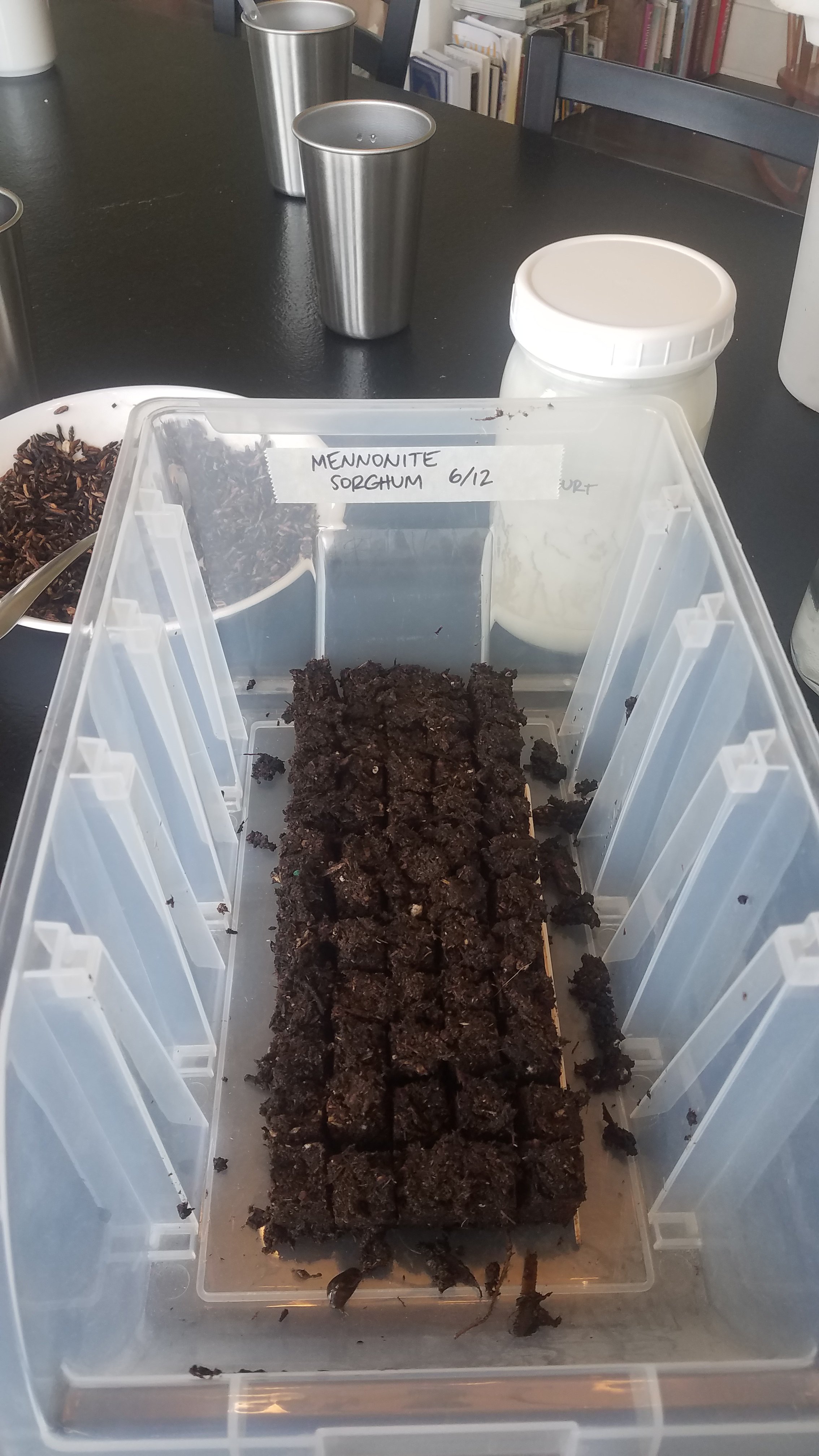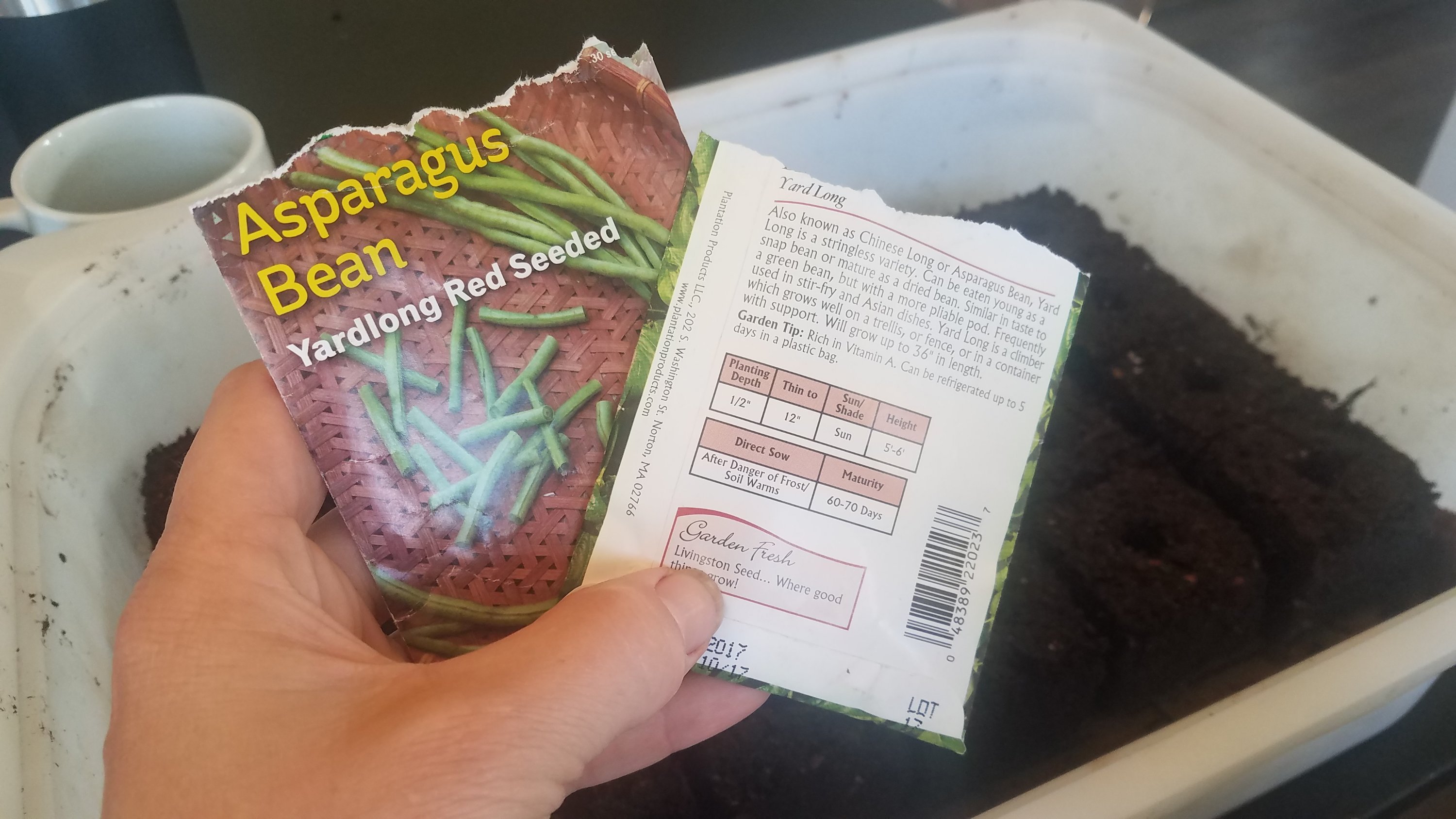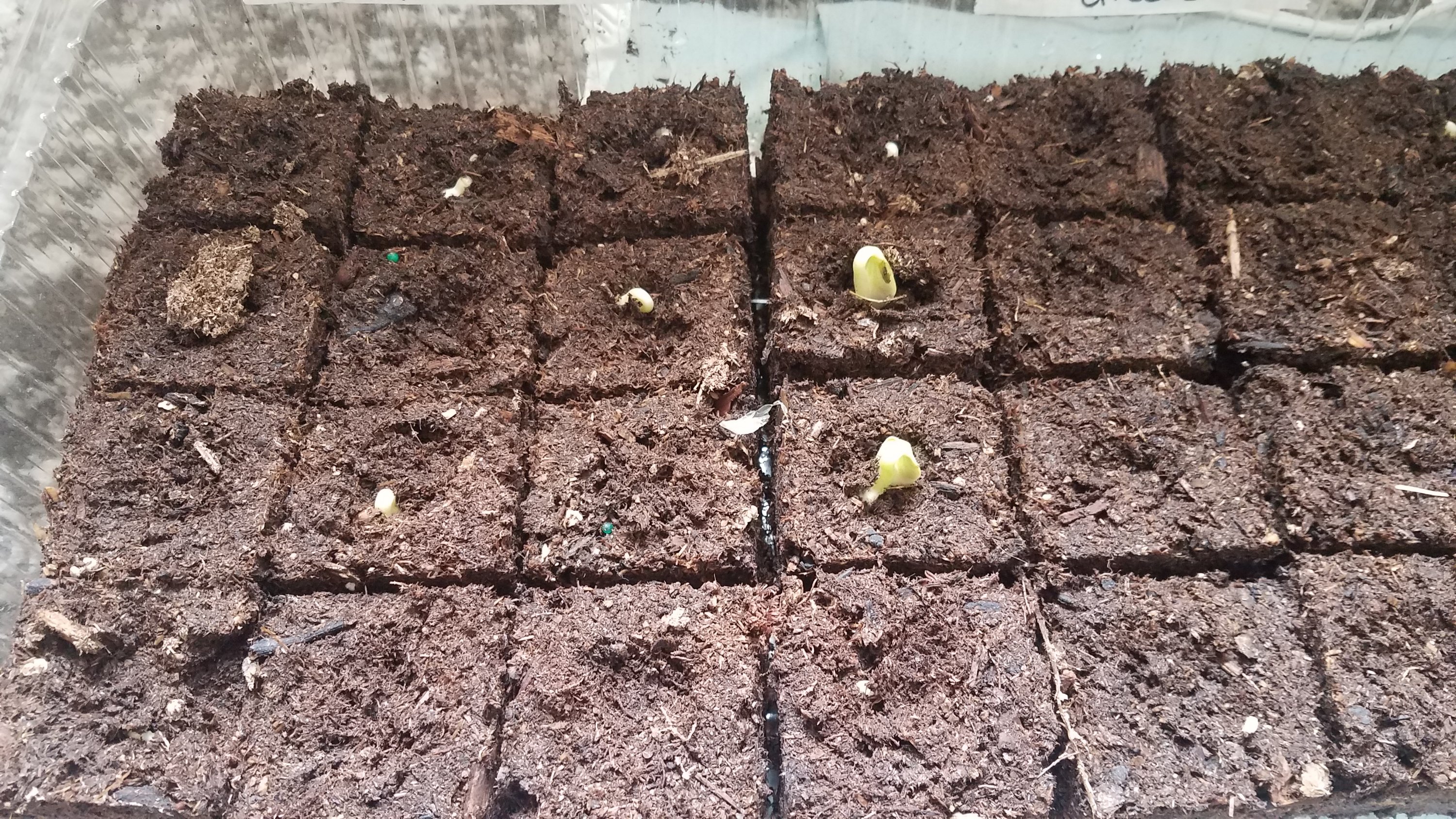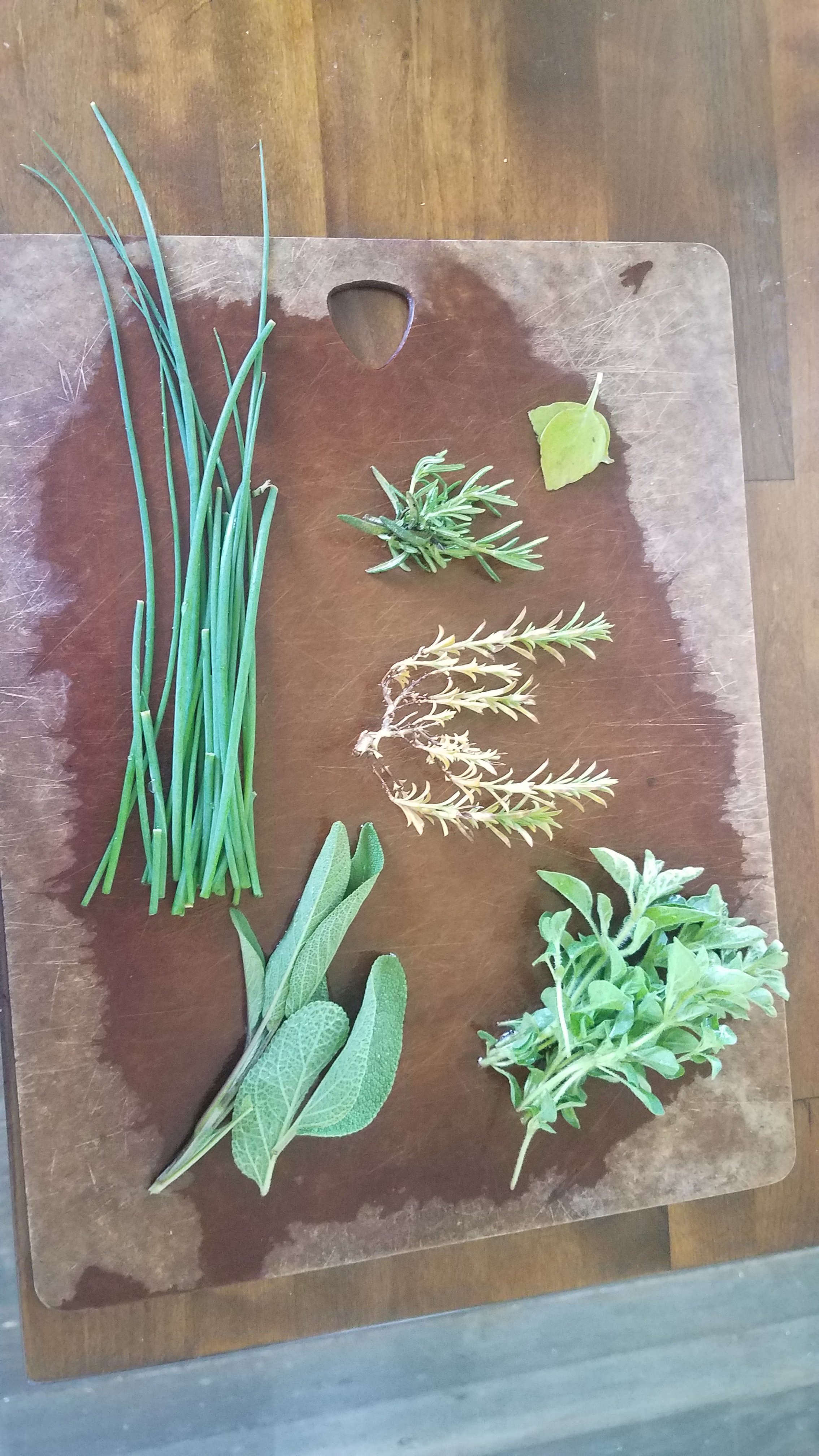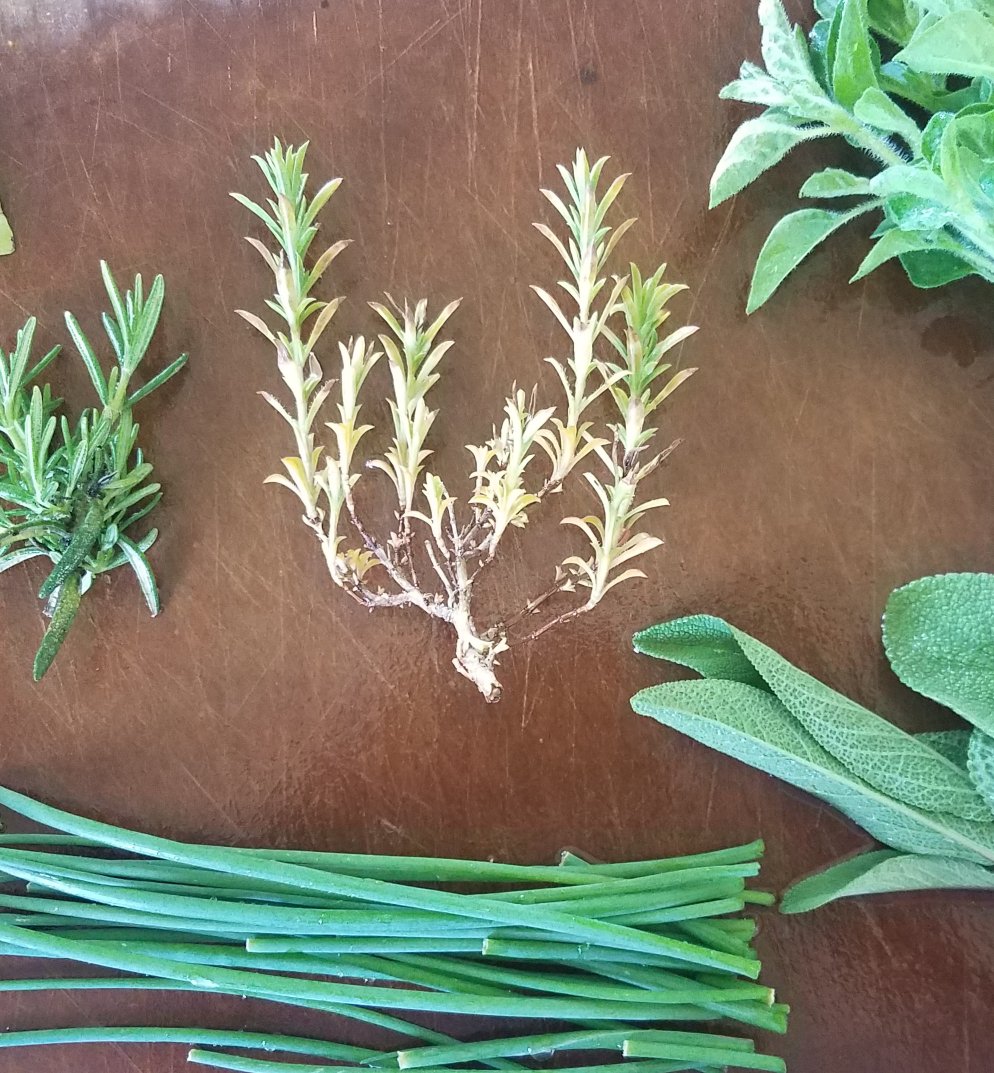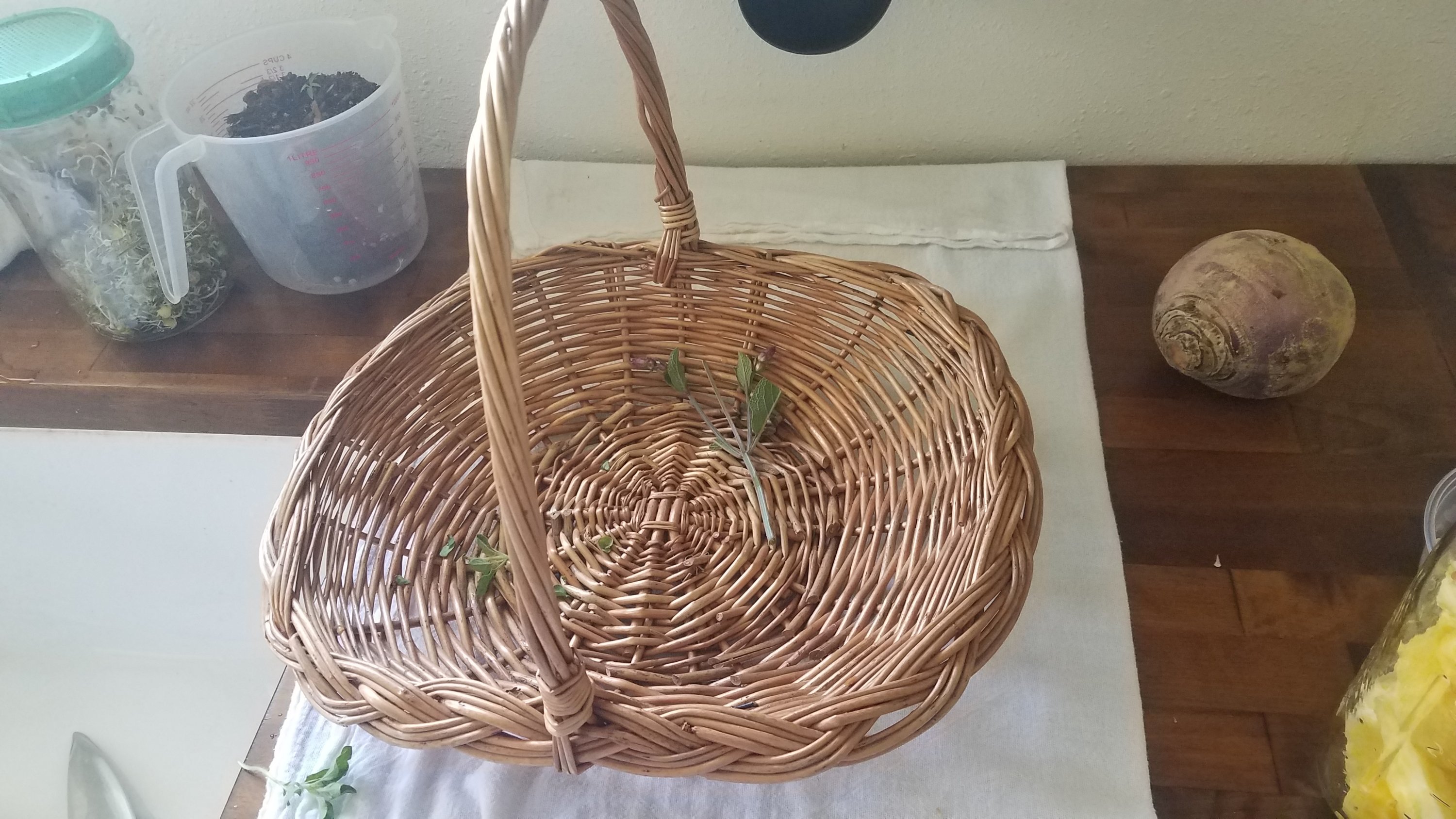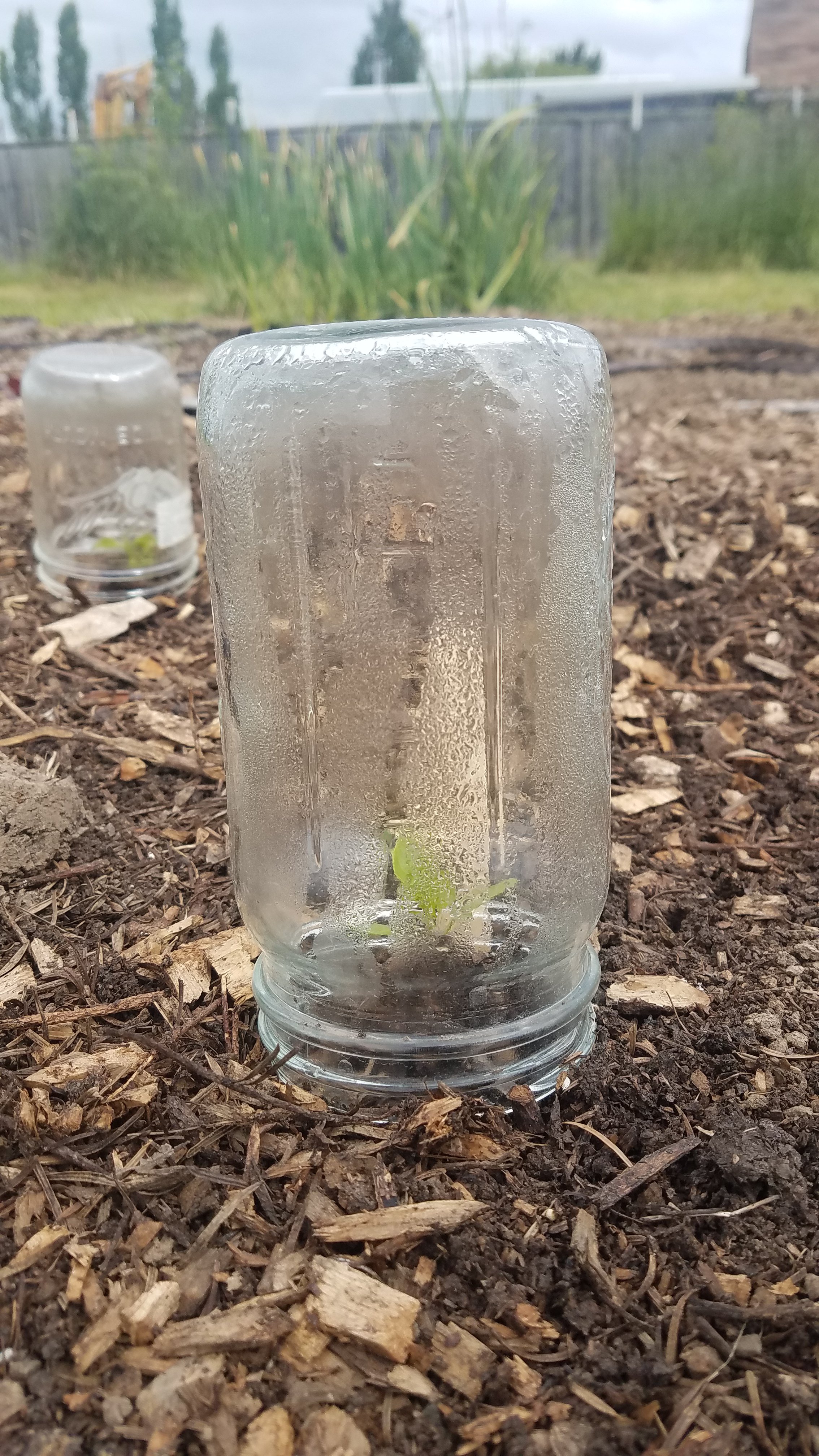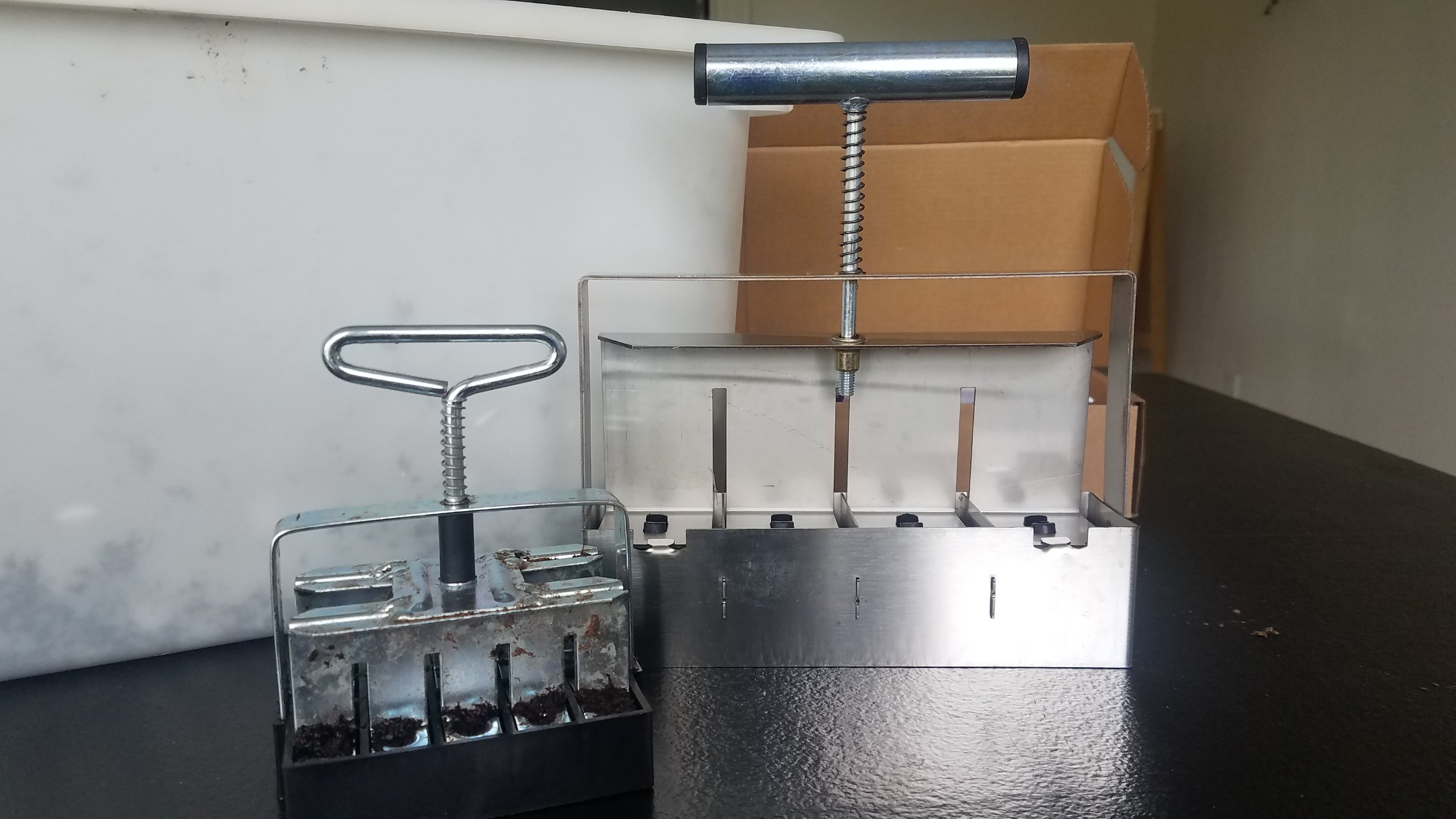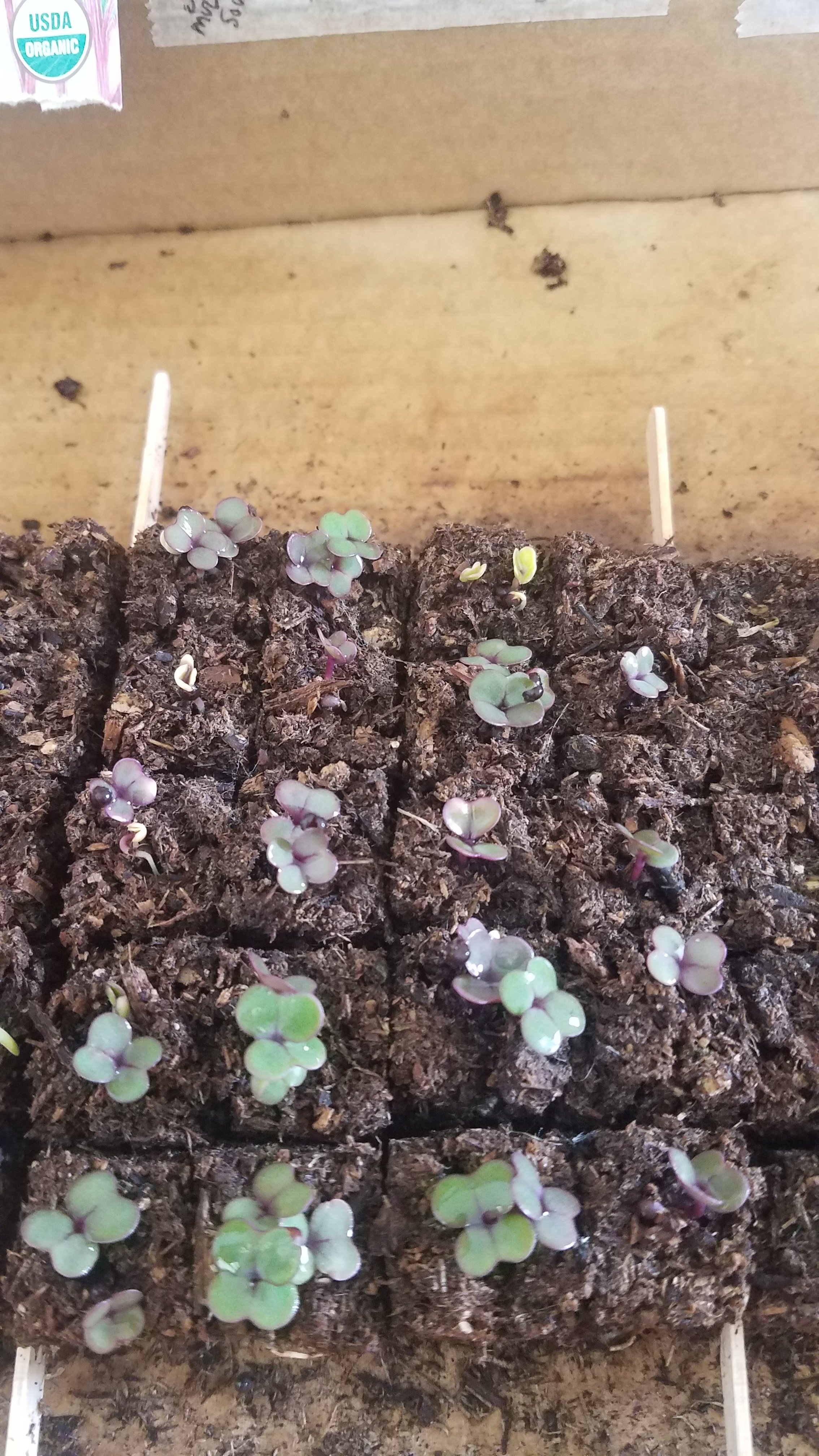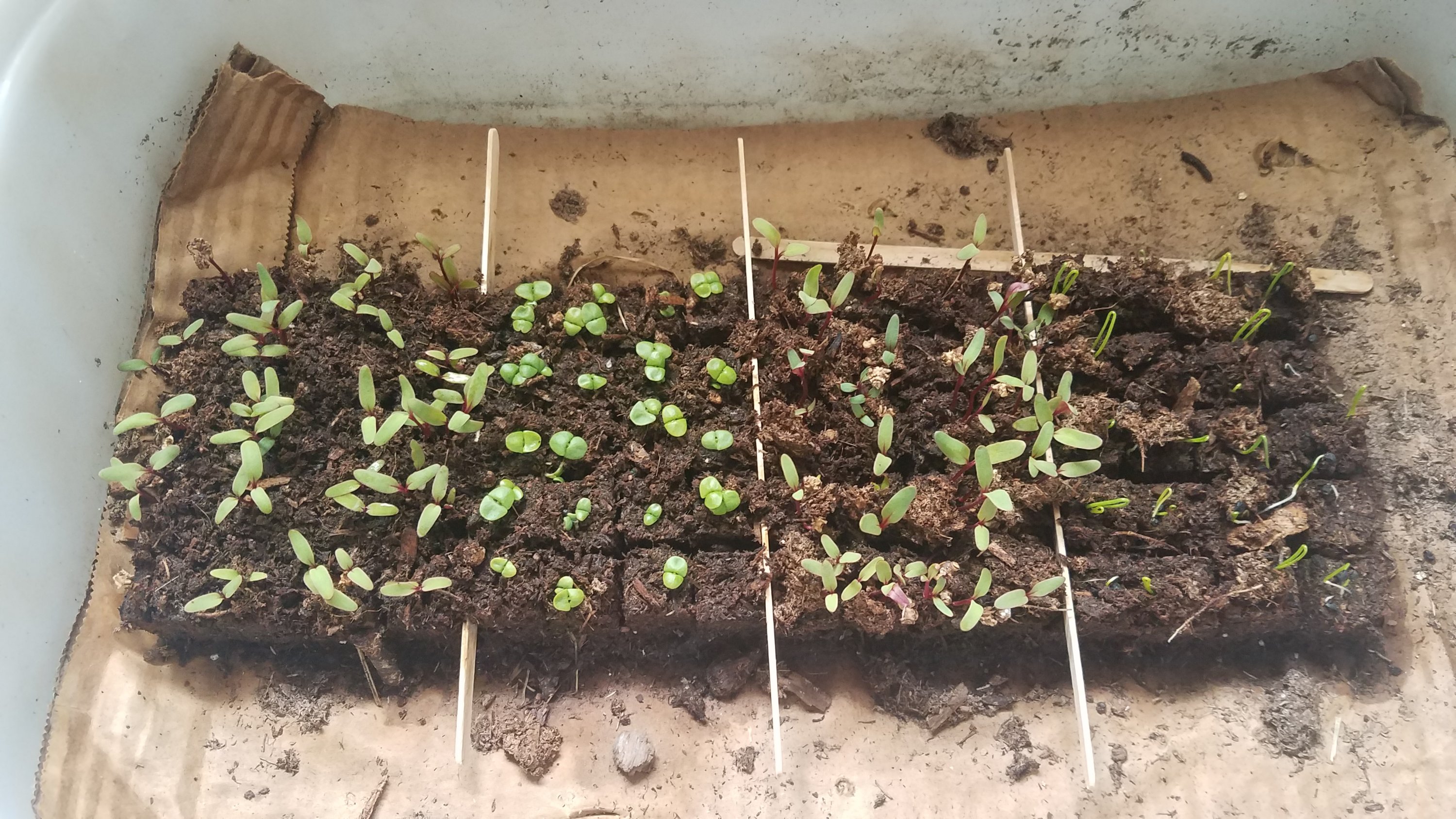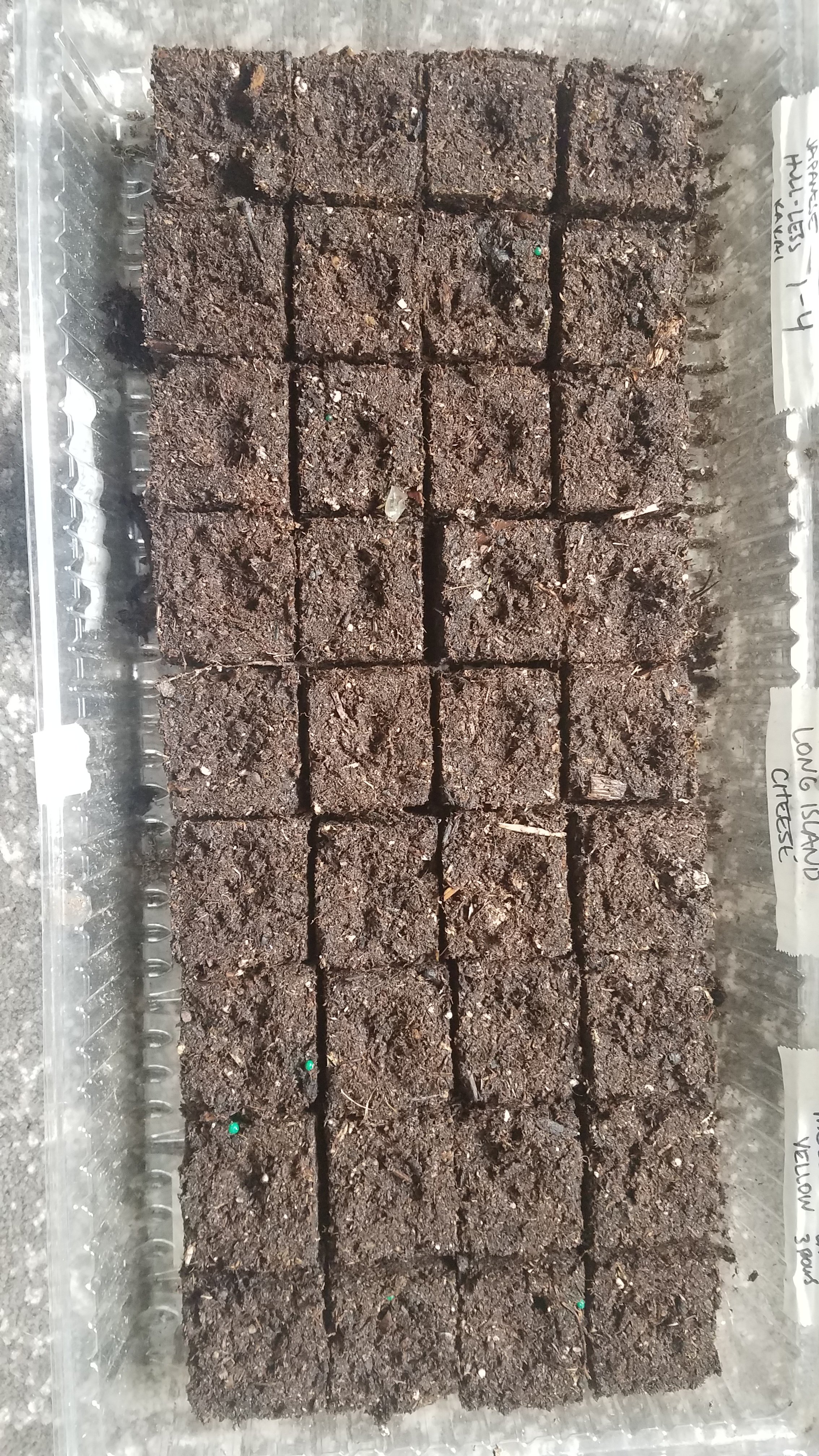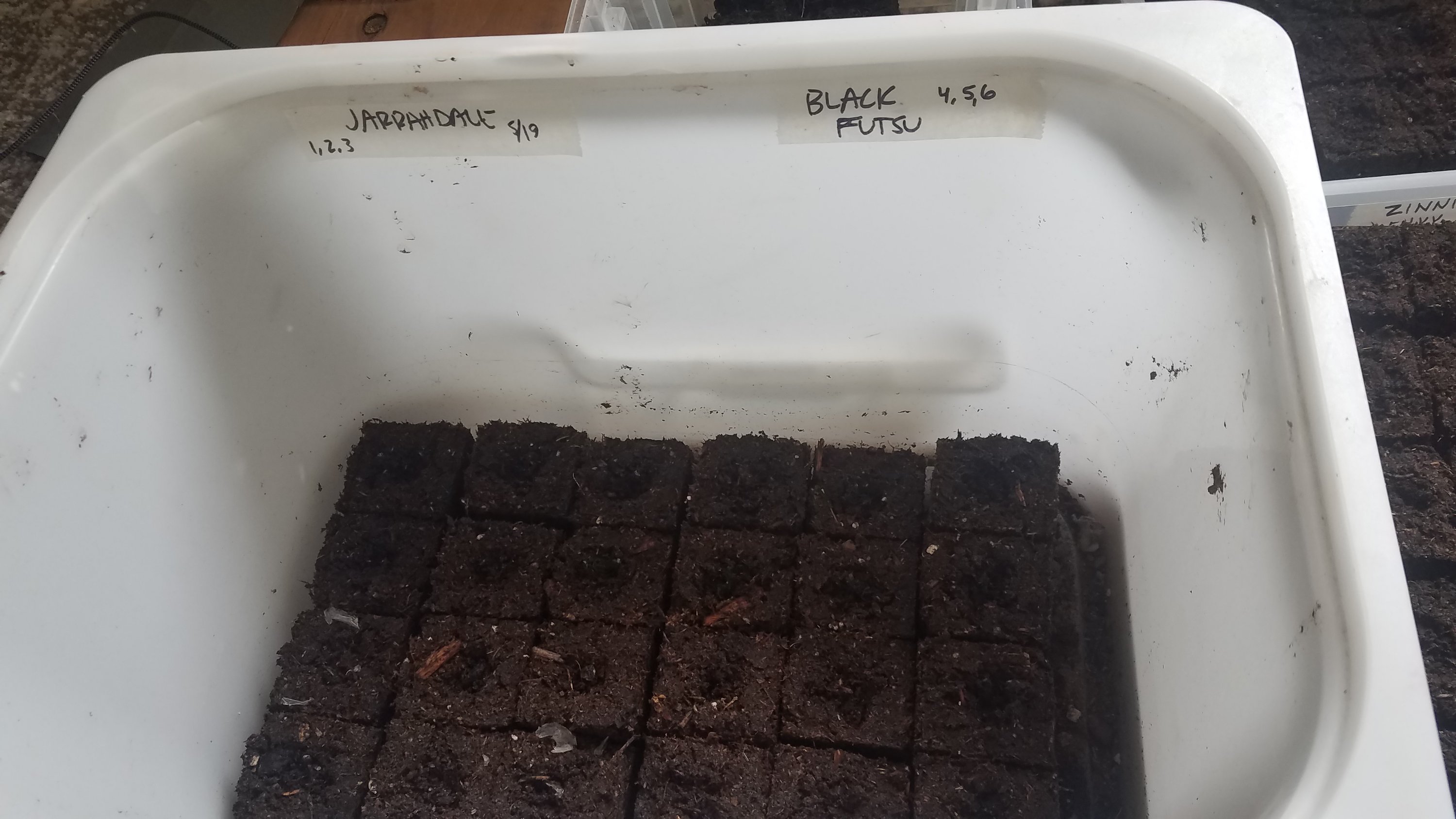Half of my first row of corn is now gone, thanks to a duck. 🙁
It’s June 14th–not even summer yet–and we’re getting small, daily harvests. (Still no peas.)
Today I cut leaves off our lettuces. I love “cut and come again” types of lettuce. It means I can harvest as soon as a leaf is the size I want, then come back tomorrow to get another few leaves. Next year I’d love to try some different lettuces. Josh was all excited this year about planting lettuce, but I wasn’t. But now I am. Lettuce is an early win. You can harvest lettuce before almost anything else (except for overwintered crops). I guess I wasn’t too excited about lettuce back in February because we had so much kale and chard. Now that it’s gone, I’m so grateful for our little patch of tender greens.
We also harvested 5 beets. We eat the beetroot and the leaves. Beet leaves always look sickly and unappetizing, but they transform when they’re lightly steamed and tossed with butter. They turn a glossy, rich green.
I cut a few stalks of what I call our “grocery store green onions” because that’s what they were. Since planting the little stublettes from the bottom of the green onions last year, we have been harvesting non stop. Something that normally ends up in the trash has been a source of reliable flavor and color for well over a year now.
We also harvested our first real cutting of winter savory. Winter savory is an herb that I almost wrote off as just an old fashioned, outdated herb. You never see it in sexy poses on magazine covers. Winter savory never gets lead roles in Broadway musicals or even bit parts in made-for-TV-movies. I really don’t know why. Winter savory has got her act together. She grows upright, has a bright, fresh herbal scent, she’s easy to grow and she fits in with any recipe (never overpowering).
It’s been a very rainy, cool weekend. Our plants are loving it (with the exception of my precious little Jimmy Nardello peppers. Those little pepper plants are struggling. They’re in the garden expansion (which means the soil hasn’t been improved, it’s a high percentage of wood chips, and they are growing on to of dead grass).
But the rest of the plants are doing the happy dance. Even the tomatoes.
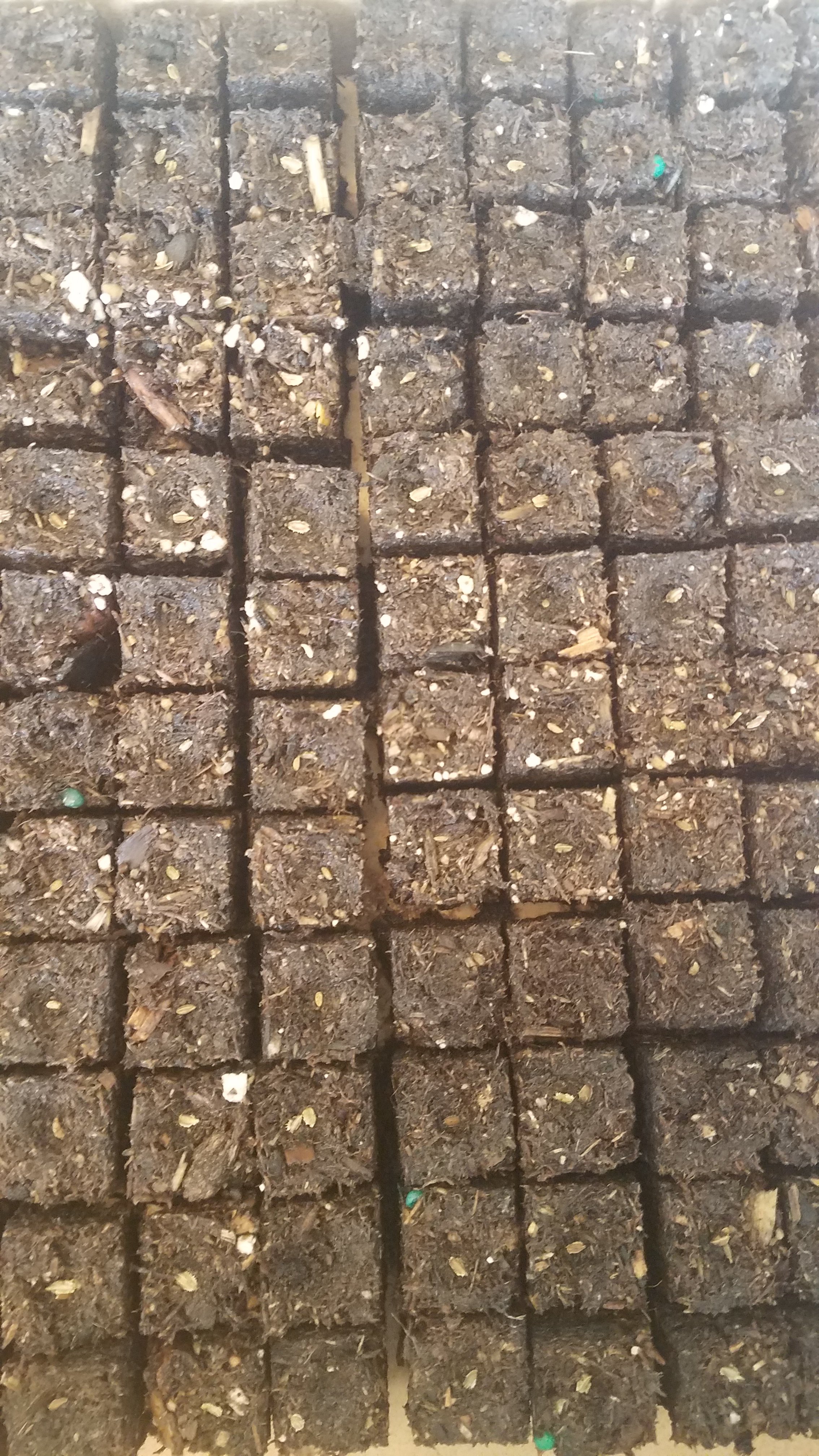
120 carrot seeds planted in little soil blocks. I WILL grow carrots. 
This copy was written by either a 1st grader or a Boomer. “Pretty and tasty, too!” Just, no. 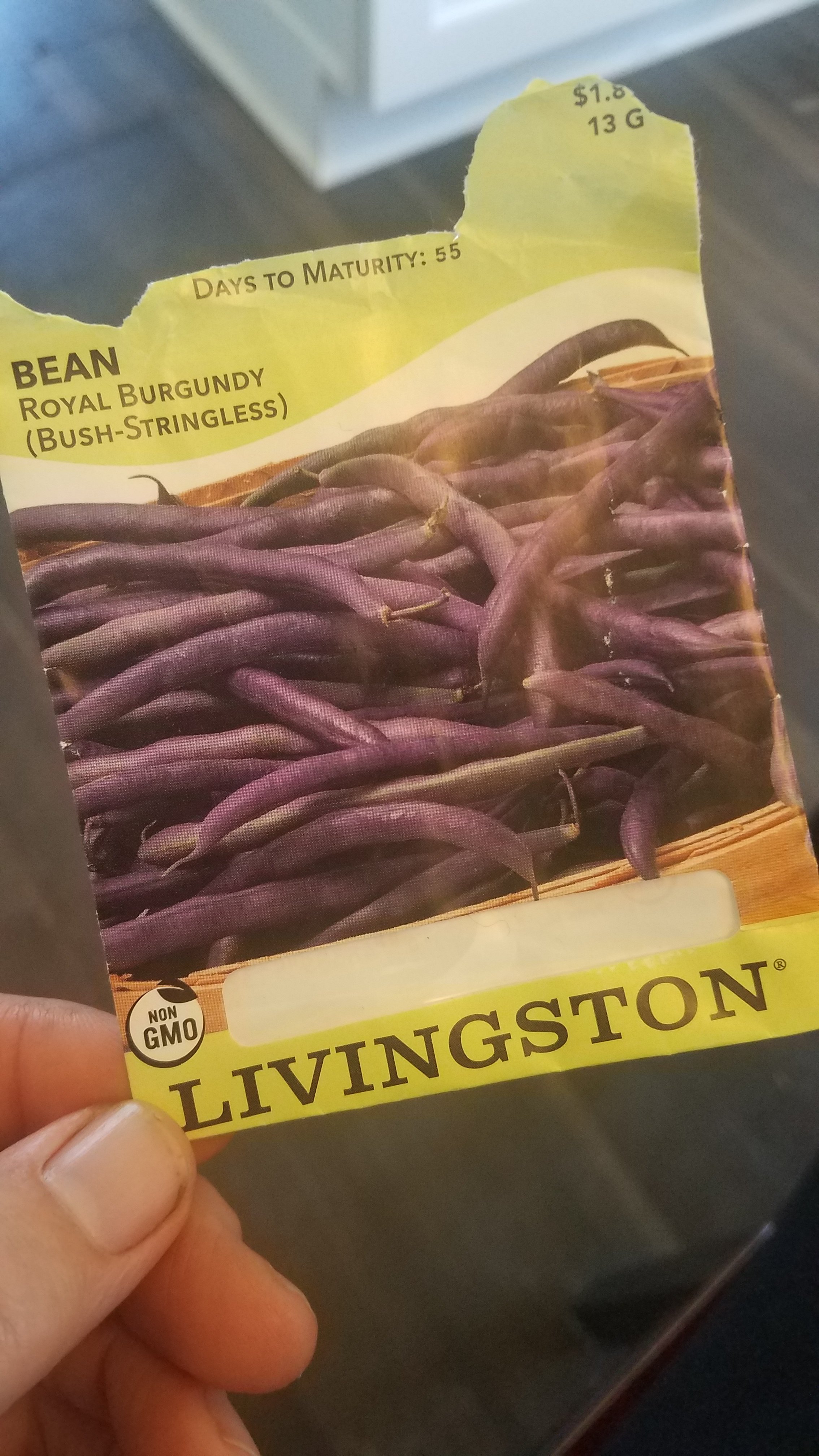
We planted these a while ago and they did better than the blue lake 274 bush. No beansies yet! 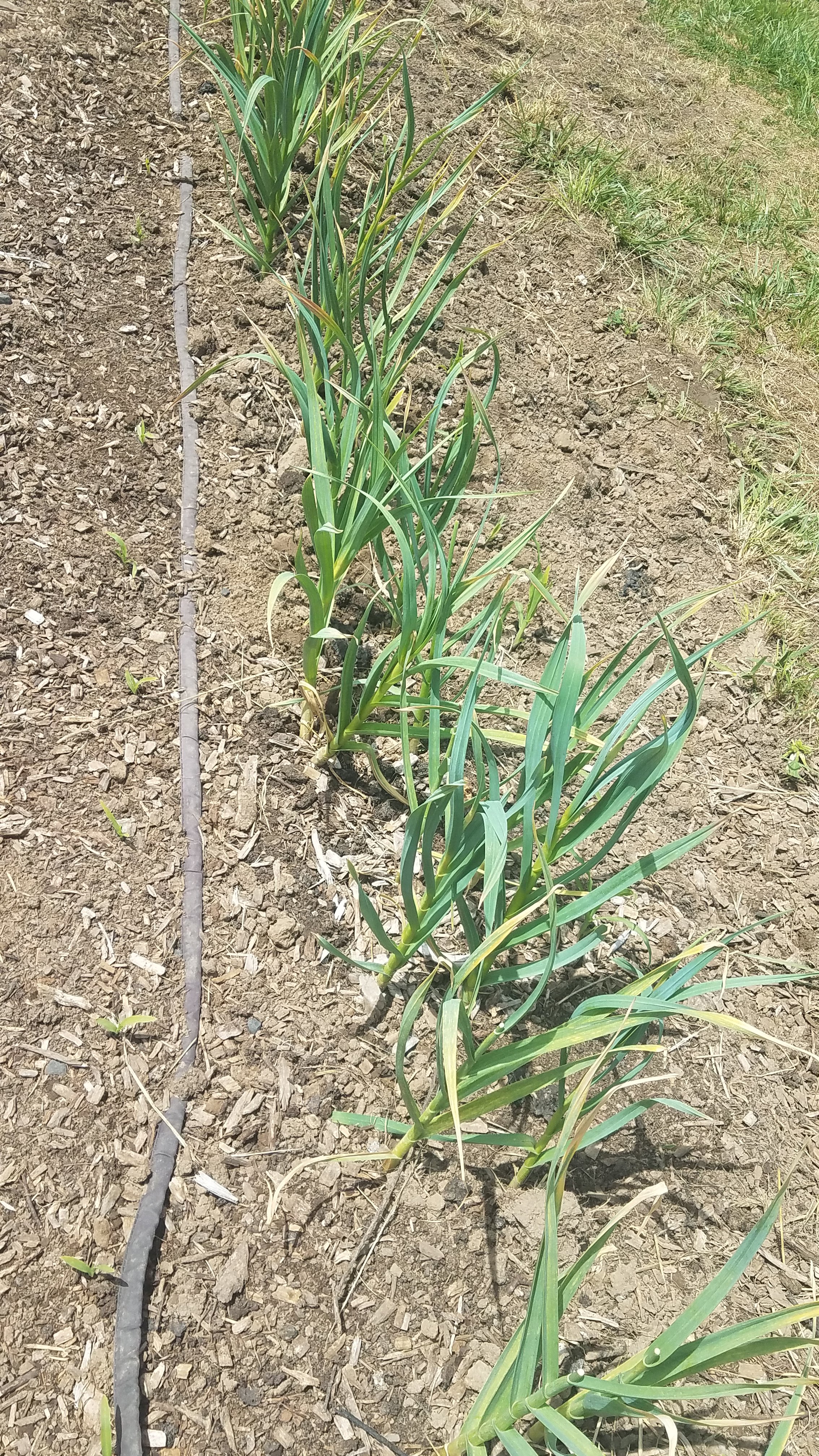
We’re a couple weeks away from harvesting garlic. This has been in the ground since Sept 2020. 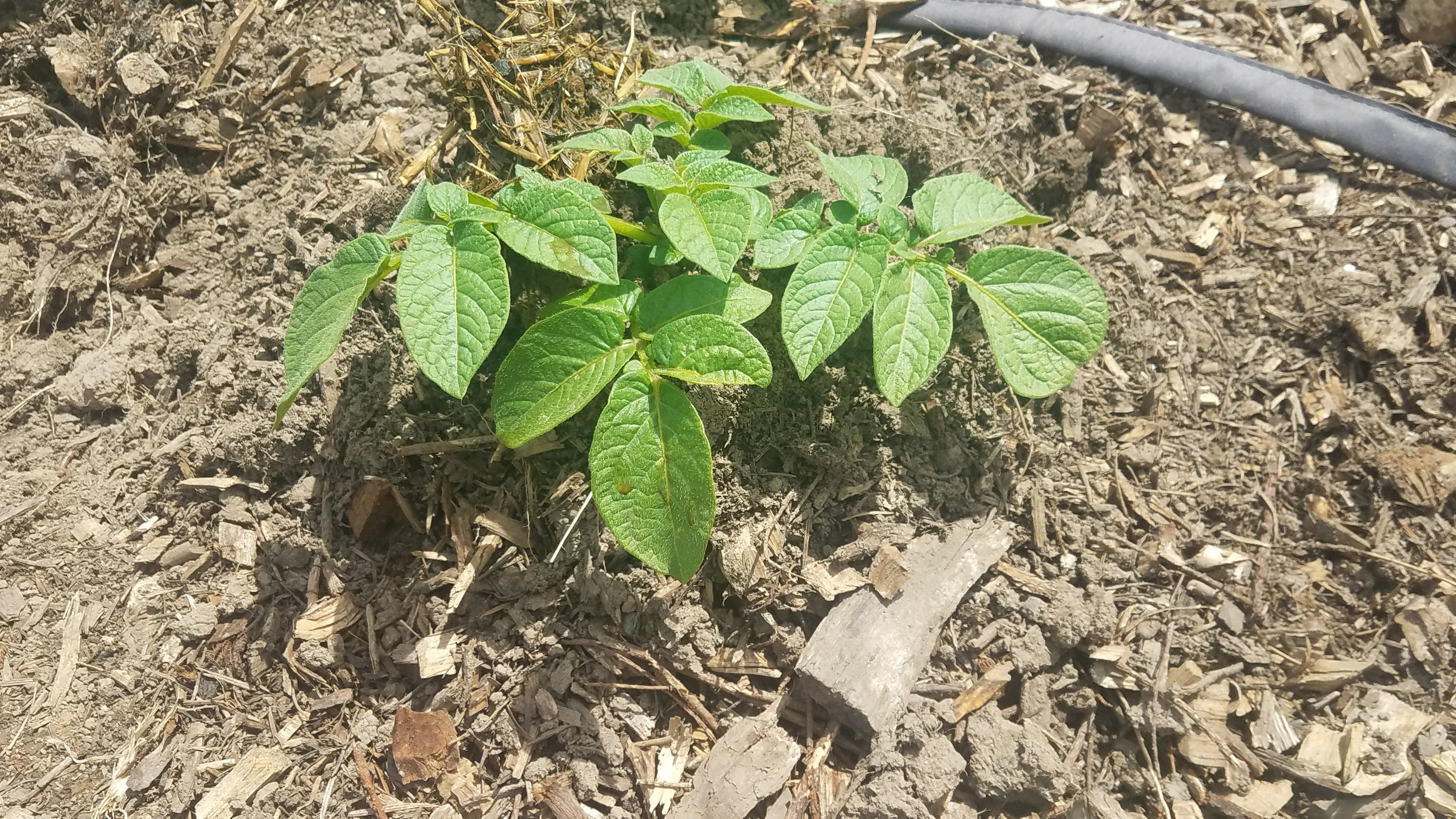
I’m still in awe that potato plants grow from old wronkly potatoes (thank you, fat thumbs, for my new favorite word!) 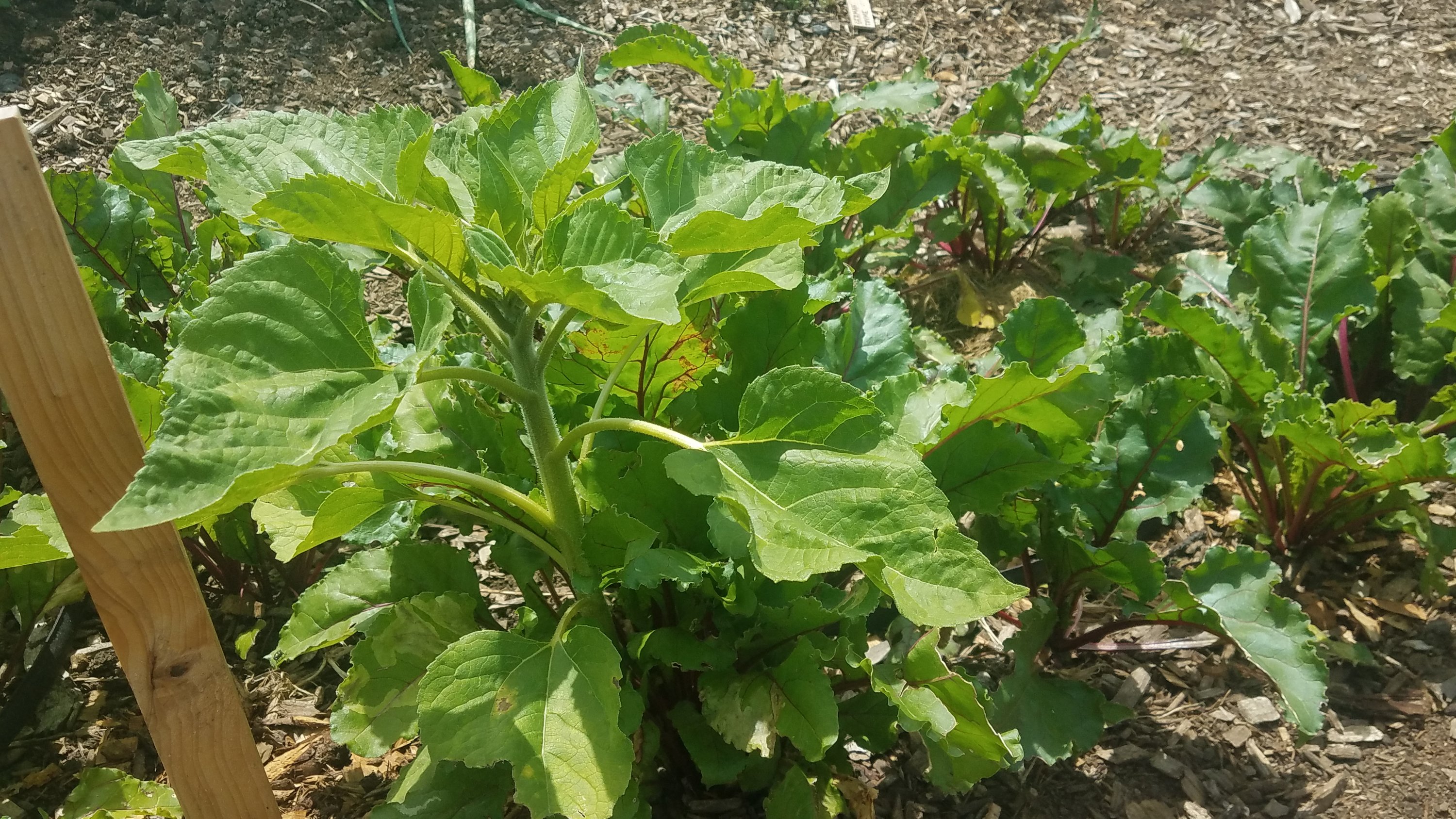
“Hey!! I’m a sunflower–the extrovert in this little garden party. Look at me, everyone!” I’ll allow it. 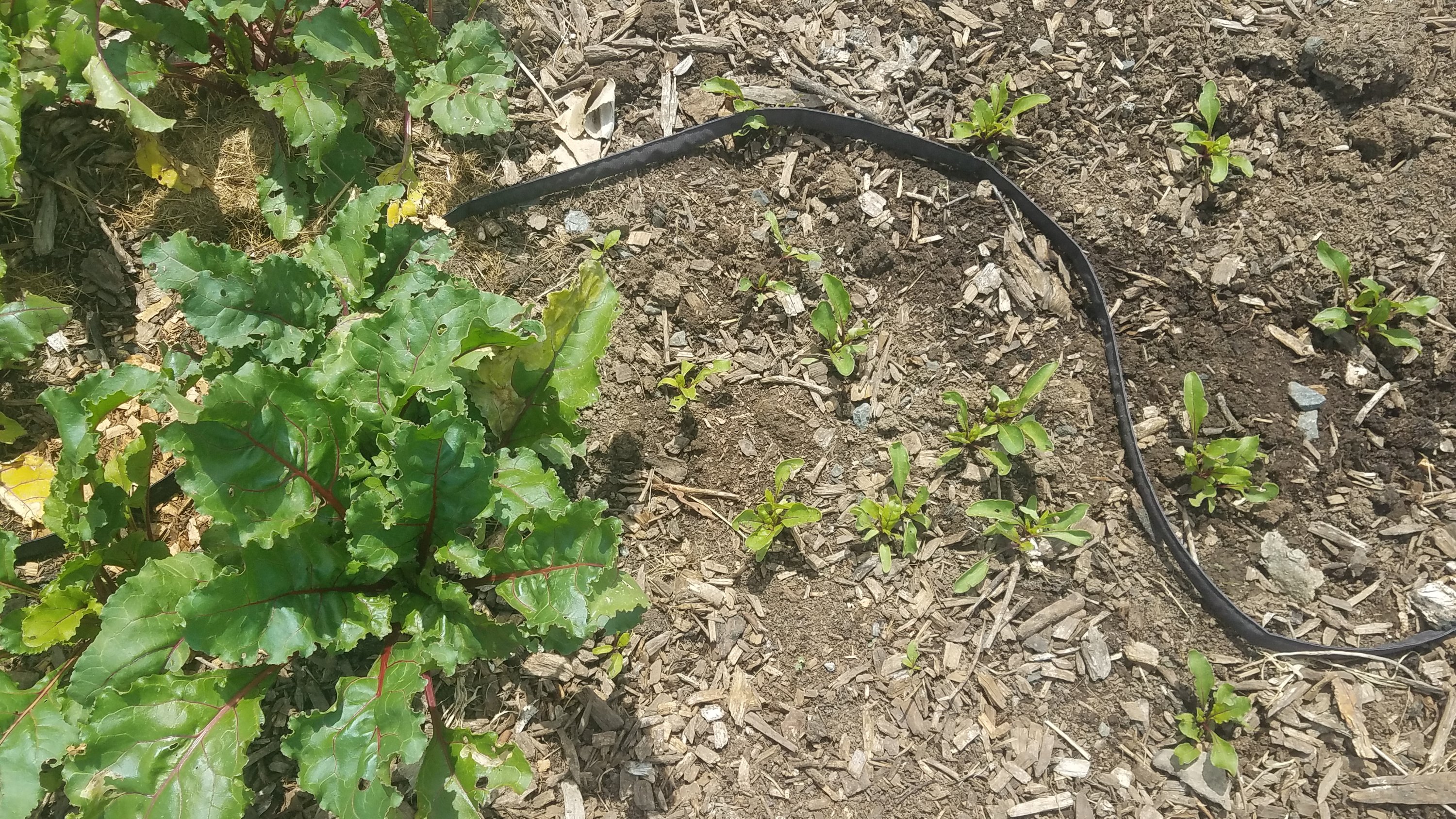
Big daddy beets next to baby beets. 
These everbearing strawberries have never seen the inside of a human digestive tract. Sad. 
The most unusual plant in our garden. A carrot. (Someone explain to me how this happened–on purpose!) 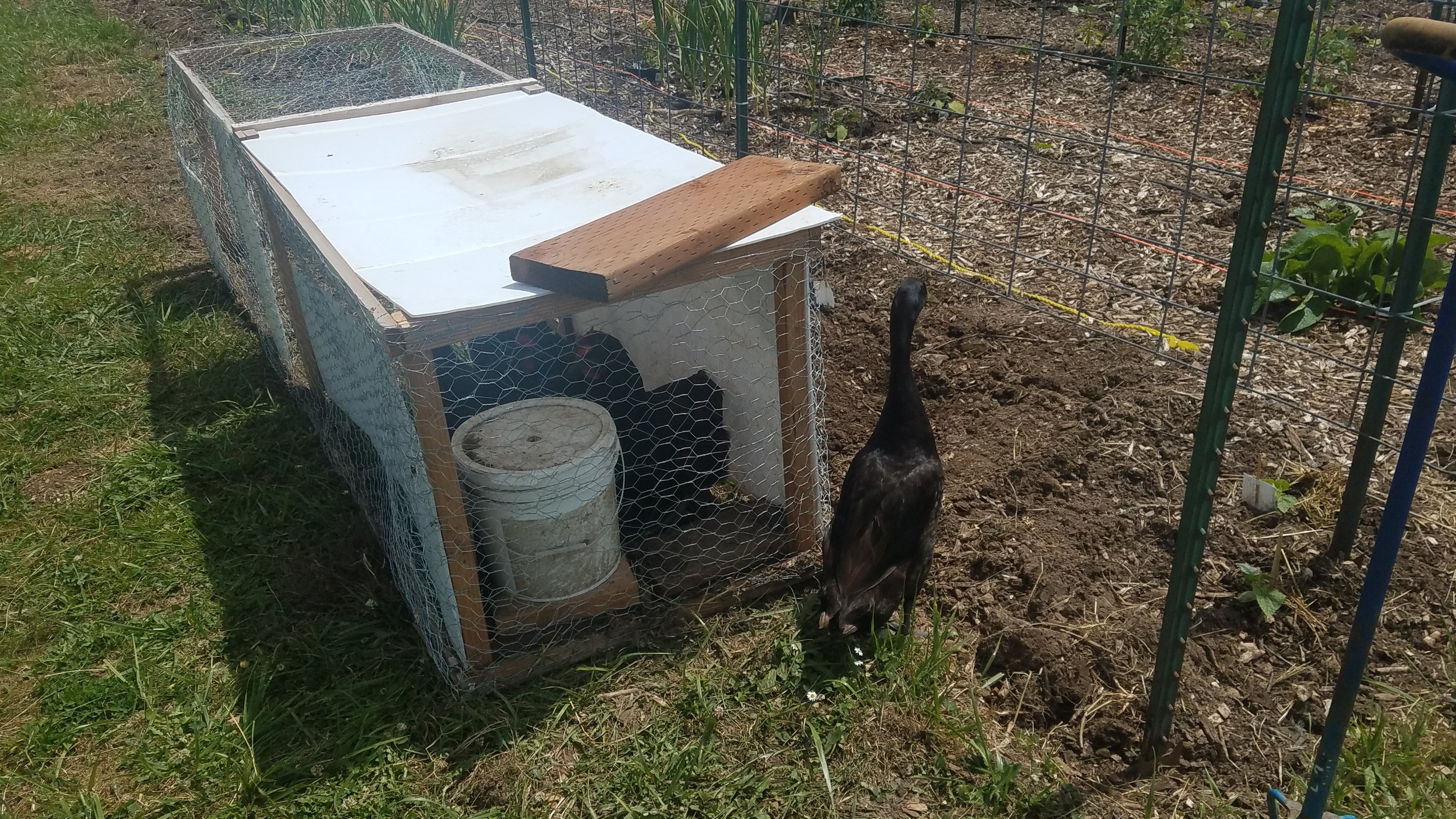
Hercules, the ministering duck. He visits the chickens maaaany times a day to check on them. 
Pee tea or poop smoothie. Either way, it’s a great fertilizer. It uses rabbit pellets, which are very safe. And delicious. 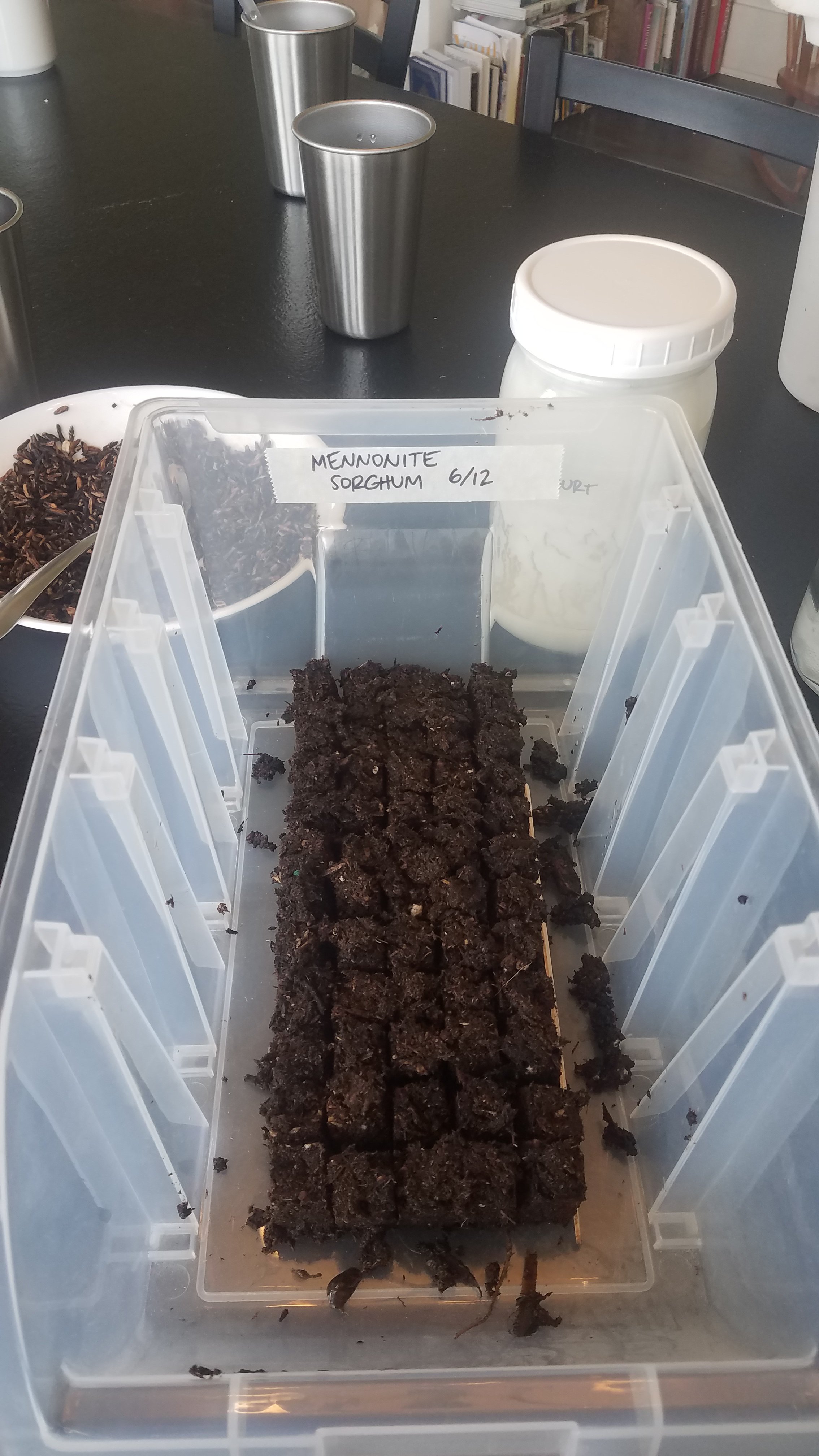
My freshly planted sorghum. I know I paid too much for these seeds. $7 for 50 seeds. Wut??
It’s June 12th, and that means there is more happening in the garden and on the farm than I can write about. We’re keeping this farm blog so that we can improve, learn and grow. It’s working! We have used this blog to see “where were at” in terms of same time last year’s garden. It’s exciting and frustrating at the same time. Things seem to move so slow, but like I said, they’re almost moving faster than I can keep up with!
My kitchen is my food lab. Three of my recent experiments are in this photo.
Yogurt: this is a whole milk yogurt, filled with good, grocery store variety bacteria, and cultured in the Instant Pot. We put it on curry, pancakes, or in smoothies.
Popped Wild Rice: Popped like corn, but 10x crunchier. Best with lots of butter and salt. We served it on our chickpea curry last night. It was, as the cool girls on TV say, “Uh-MAY-zing.
And the last item in the photo is the one I’ll be holding my breath for–Mennonite sorghum. I feel like the secret to being self sufficient is growing storable calories. A.K.A. graaaaaains! We had great success with corn last year (as a fresh vegetable), so this year we’re expanding to include Mennonite sorghum, Bloody Butcher dent corn, and purple hominy. And yes, we will nixtamalize our corn and hominy (if you’re wondering). There is no proven link to autism or Alzheimer’s connected with nixtamalization, and we feel confident and safe with the process, so we’re moving forward–no matter what judgement we receive from others. Part of being a homesteader is being confident in your decisions, no matter what the fallout is.
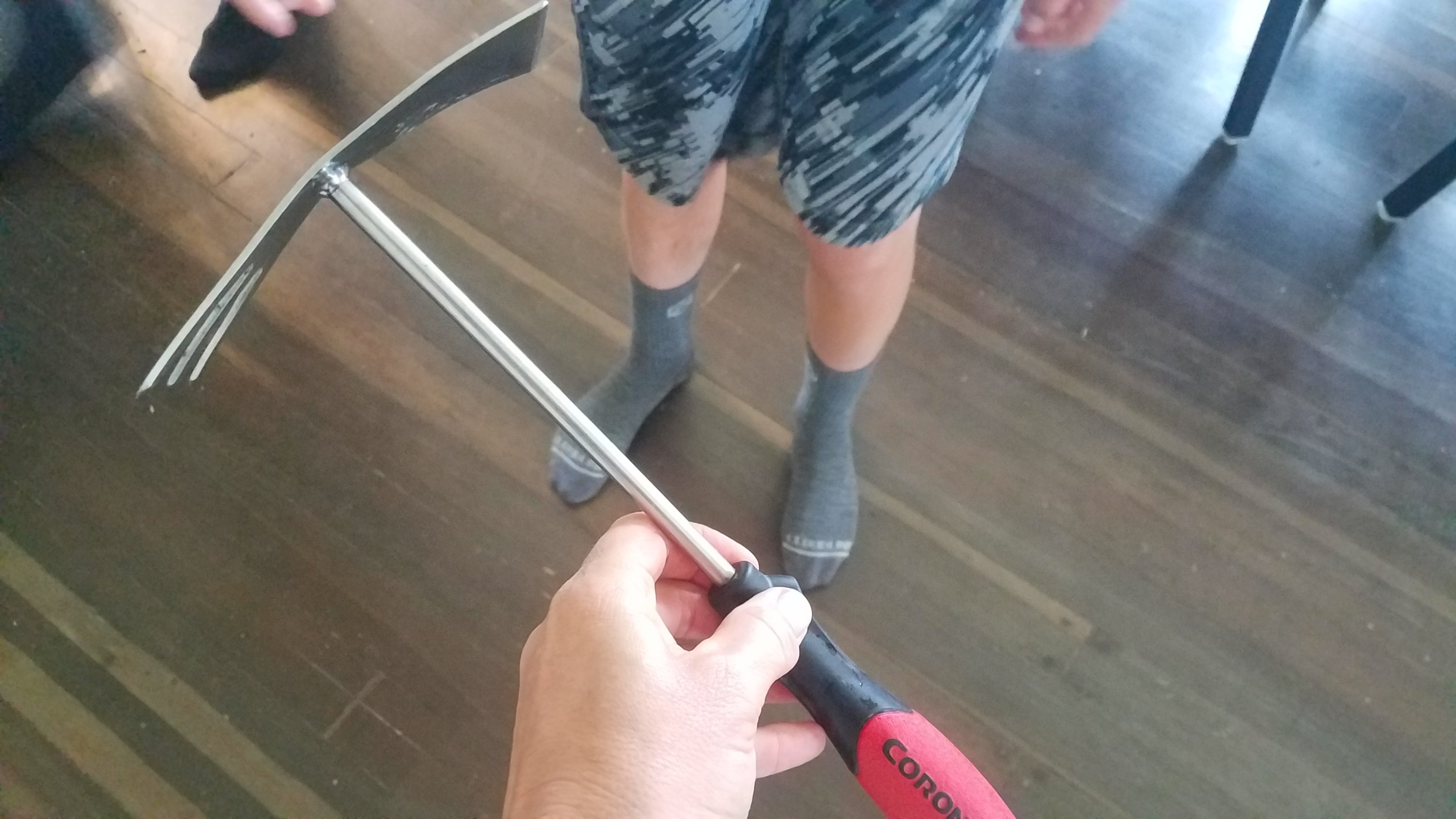
My favorite garden helper(s)
My 13 year old son has the heart of a farmer. He loves planning, envisioning, designing, growing, nurturing and harvesting. In fact, our neighbor (and good friend), John, calls him “Farmer Grant”. Grant’s always outside, riding the tractor, mowing grass, collecting hay, feeding animals, pounding T stakes, cleaning up or giving our sheep “scratchies”. If you ever see Grant indoors, he’s usually either eating food or impatiently pacing the floor waiting for his next farm project idea. I adore Grant because he is my farm friend and we love spending time together outside.
If there’s “farmah drama” (ALWAYS!!), we figure out together what’s causing it. We dream together about growing lavender, sunflowers, sorghum, and hominy. We looooove projects. We’re both dreamers and doers. Grant isn’t afraid to use power tools or get all sweaty and dusty. He astounds me with his innovative farm solutions. I couldn’t imagine Chehalem Prairie farm without him.
And do you know another 13 year old who asks for farm tools and farm equipment for birthdays? Like I said, he’s got the heart of a leather-handed, muddy-booted, sweaty, tender-sweet, 1850s farmer.
P.S. That other thing in the picture is my go-to garden tool. Great for busting up rocky soil, weeding, and planting. It helps me get a lot done, but not as much as Grant does.
God is good. He put variety on the earth in such astonishing abundance that there’s no way we can discover all his good gifts in one lifetime.
I know a little about God’s abundance. I’ve been gardening with Josh for 22 years (we even planted a garden together at the house where he lived while we were dating). We’ve grown tomatoes, beans, corn–all the garden favorites. We’ve been able to eat, preserve, ferment, dehydrate and share so much of our garden’s abundance.
But yesterday, I found out– MIDLIFE–that there’s a garden fruit that I’ve never heard of. It’s not that I’d never grown it, or never bought it at a farmers’ market, or saw the seed packet and was not interested. Nooo. This fruit had never before made an appearance in my life–ever. I had never heard of ground cherries until yesterday.
And here’s why God is good. I discovered ground cherries last night while watching a garden tour on YouTube. And, it’s not too late to plant them. Aaaaand, our local real nursery had two varieties in stock. It’s miraculous to me…I love that God put ground cherries on the earth, that I discovered them, that there was still time in the summer to plant them and that our garden store had them in stock.
I don’t know how they taste (other than hearing other people’s descriptions) but I’m excited to try a new fruit and explore all its possibilities.
The two varieties we got were Pineapple and Aunt Molly. They’re planted by the beehive, just outside of the pasture. They’re surrounded by peppermint, comfrey, marjoram, oregano, mullein, and a volunteer pumpkin plant.
Garden Plan 2022
Garden 2022
GARLIC: Plant 200 cloves of hardneck garlic along south side of grape vines at the end of September 2021. The grapes don’t start fully leafing out in the spring until the garlic is almost done. Plant garlic on west ends of garden rows. Stop watering when it starts to get dried leaves. We’re using garlic as a pest deterrent. It seems to have worked this year (2021) We’ll harvest at the end of June when the bottom three leaves have turned brown and the bulb is nice and formed.
SQUASH: Plant squash in the area around the beehive, where it can sprawl and take over.
Start all plants in 2×2 soil blocks. Put together a more nutrient dense soil block mix. Ingredients are in the shed.
KALE + CHARD: Plant kale and chard as early in the spring as the weather will allow, before the overwintered ones languish and go to seed. Try saving seed from kale this year.
CARROTS: Keep trying with the carrots. You’ll find your system. The board worked, but I’ve also seen people have success with burlap, watering twice a day. I want to try this idea.
TOMATOES: 3-4 Juliet Tomato plants in the garden, and 4 Sungold Cherry Tomatoes on the east side of the house. I love that smaller tomatoes come on sooner. I want to use the Juliets to make a year’s supply of sun dried tomatoes, as well as pizza sauce and salsa. More varieties for paste. Maybe some slicing? Definitely more than 11 plants. We need more tomatoes.
CUCUMBERS: The Boston Pickling seemed to do well in 2021. Don’t over crowd them in 2022. Let them have more room. Also, say nice things to them. They got bitter as the season progressed, so rethink this plan, mebs.
MELONS: Don’t grow large melons. Grow some that are specific to Oregon and our climate. Maybe some small melons. Watermelons take too long.
ANNUAL HERBS: Plant ALL annual herbs on the south side of the house. This will include dill, basil, chervil, cilantro (spring/fall), Keep annual herbs out of the perennial herb garden.
FLOWERS: Move all flowers to farm stand and front yard. Have a mix of annual and perennial flowers. 2022 mix will include Merrie’s California poppy seeds, the poppy seeds from the Fossil schoolhouse, the Calendula seeds from Champoeg Kitchen Garden, some sunflower from bird seed, some Rose Campion from the Newberg Library, some saved zinnia seed, and whatever else I can forage over they next few months. I want the front of our front yard to be so full of flowers that it’s ethereal.
PEPPERS: We might not need to grow hot peppers in 2022. But it might be fun to grow the Jimmy Nardello peppers along with maybe another variety. We could split them up and put the other variety with the tomatoes on the east side of the house. It might be super fun to grow a mild version of jalapenos, like the Pablano/Ancho peppers we’re growing this year on the south side of the house. Grow long skinny sweet peppers. At least 30 plants. Plant them closer together. Start 8 weeks before planting outdoors.
Use floating row covers for spring plantings.
FERTILIZER: Keep doing the liquid plant-based fertilizer. It’s working!!!
Save seeds: as many as possible from the plants that aren’t cross polinated.
Grow overwintered crops
Control thistles by mowing. Also, thistles can be harvested and turned into liquid fertilizer because of their deep taproots. They are very nutrient dense.
Re-woodchip the garden perimeter and pathways.
Prepare for perennials in our landscape: artichokes, asparagus, maybe another fruit tree?
Keep the garden going year round.
Add chervil to herb garden
Make strawberries go vertical to avoid slugs. Or give them all away.
Pay attention to the currant bush. Maybe prune it in July 2022. Give it a little love. Also, make a plan for the ground cherries and the raspberries. They’re not thriving out by the pasture. Maybe that ground isn’t fertile enough yet.
Plant more tomatoes
Early cherry tomatoes
Plant- San marzanos, Juliet, sungold
Chinese long beans again? For pickling?
No drying beans, just no.
Plant sweet potatoes, grow own slips
Plant cabbage in September?
Yellow beets and red beets and white maybe purple?
Tons of wildflowers in front yes!! Upick
Annuals herbs in south yard: dill cilantro basil fennel, coriander, cumin
Sunflowers next to John’s fence???
Use a greenhouse made of our wire shelving!
Grow CUMIN on south side!!
move the perennial flowers to the ditch!
Area next to the house ALL Annual herbs!
Move squash to outside ofpasture
Soil block recipe
3 (five gallon) buckets of peat moss or coconut coir
2 (five gallon) buckets of perlite
2 (five gallon) buckets of compost
1 (five gallon) bucket of garden soil
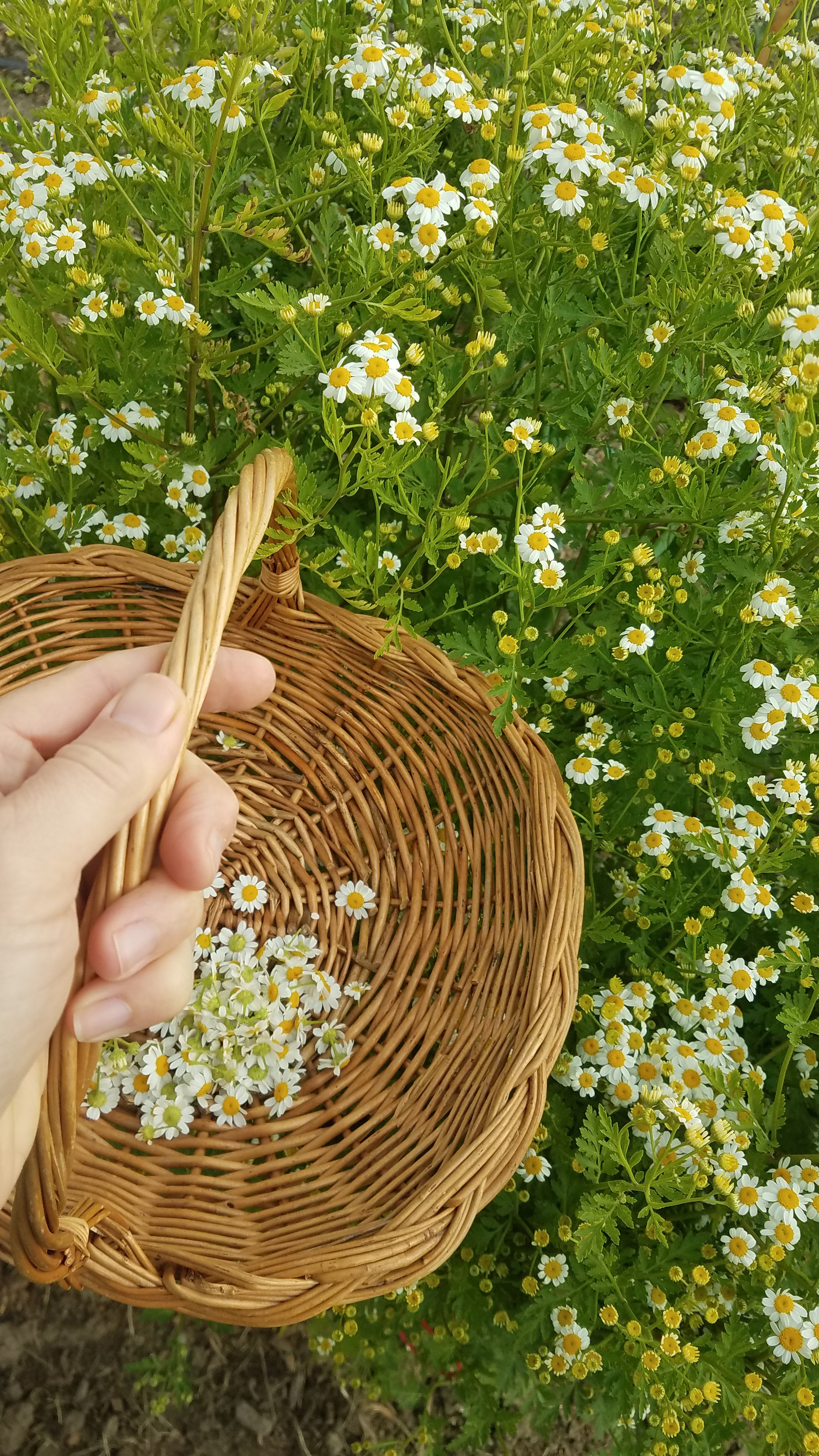
Chamomile blossoms 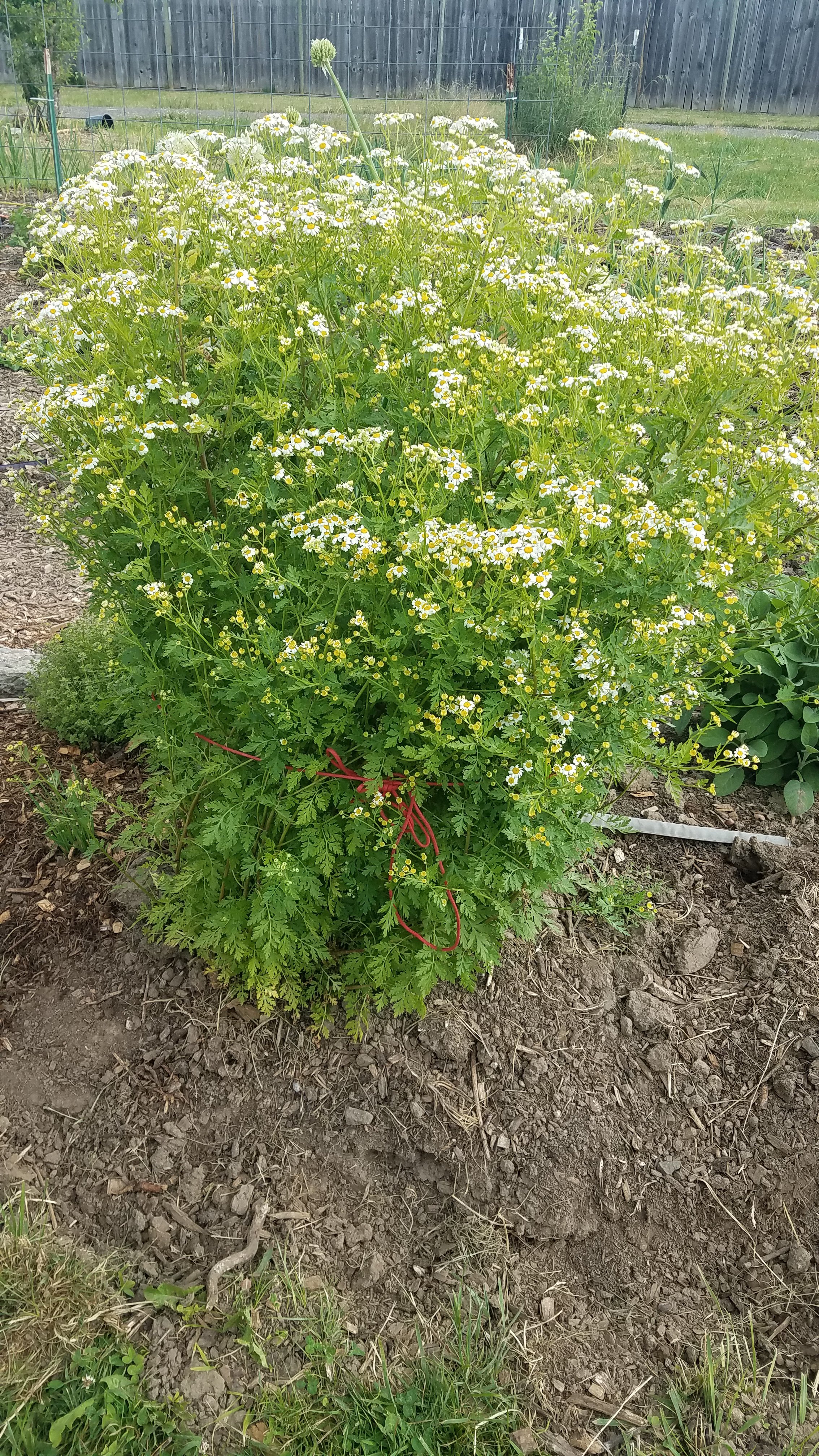
Very tall chamomile plant 
So, so pretty
Last year during the middle of Covid, I went to Champoeg State Park to visit their beautiful vegetable garden. Usually they have vegetables for sale, but since there was no one there to mind the store, the park ranger on duty said I could harvest whatever I wanted to.
We left with some beautiful vegetables, along with some perennials that I divided from their garden (hyssop, chamomile, lambs ear, and some other perennial herbs that I can’t remember now).
Well… That 4-foot-tall plant in the above picture was the little chamomile I divided from Champoeg. When I brought it home last year it was so very small (like the country El Salvador), so I assumed it would stay that way.
Today I harvested my first batch of chamomile flowers! The secret is to harvest them in the morning before the volitile oils have dissipated in the hot sun. Then let the blossoms dry out completely. Once they’re dry you can store them and use them to make chamomile herb tea.
And here’s how I say Chamomile: CAM-uh-meel, because I ain’t no pretentious foo.
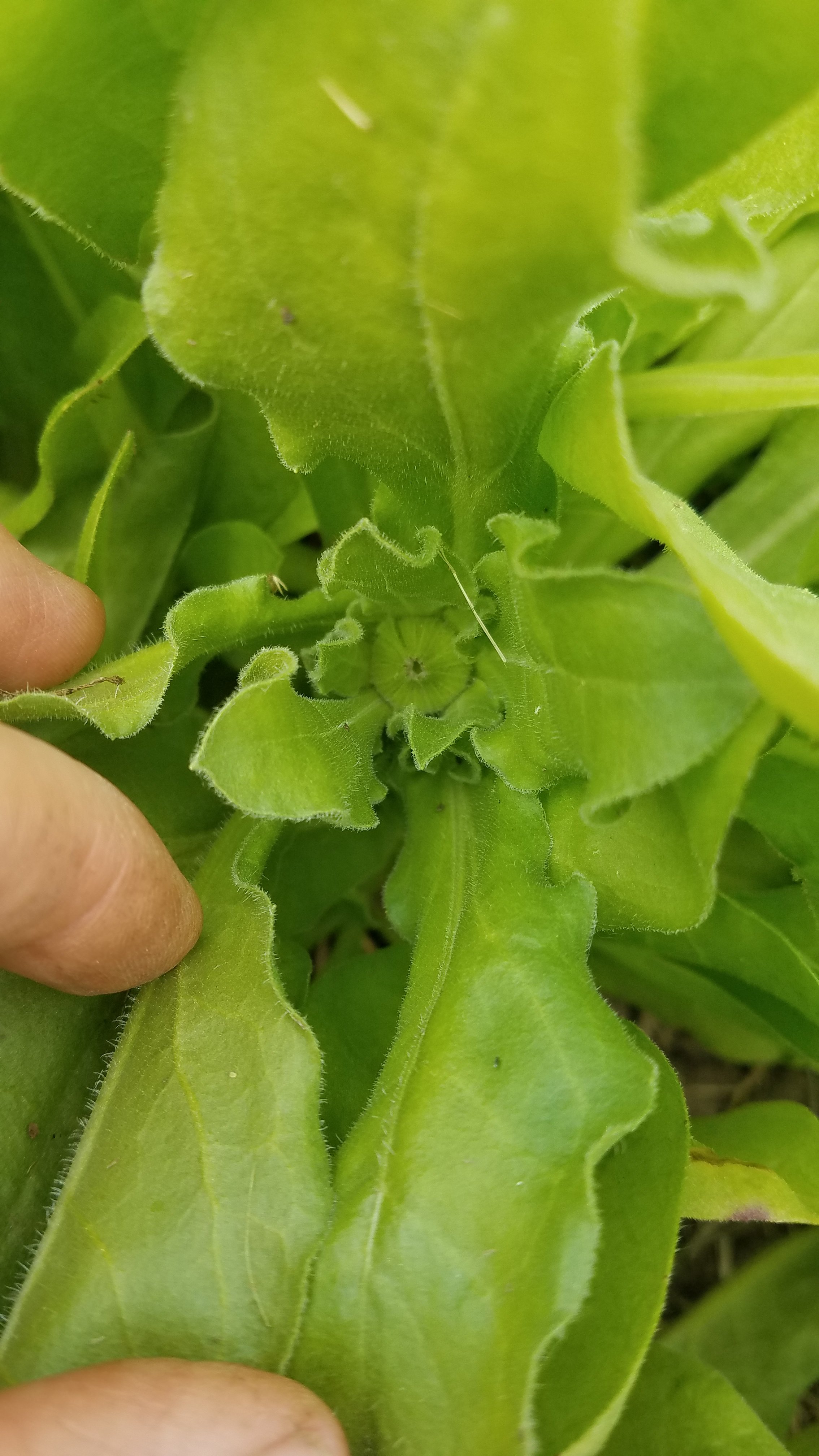
First calendula bud from my medicinal herb garden 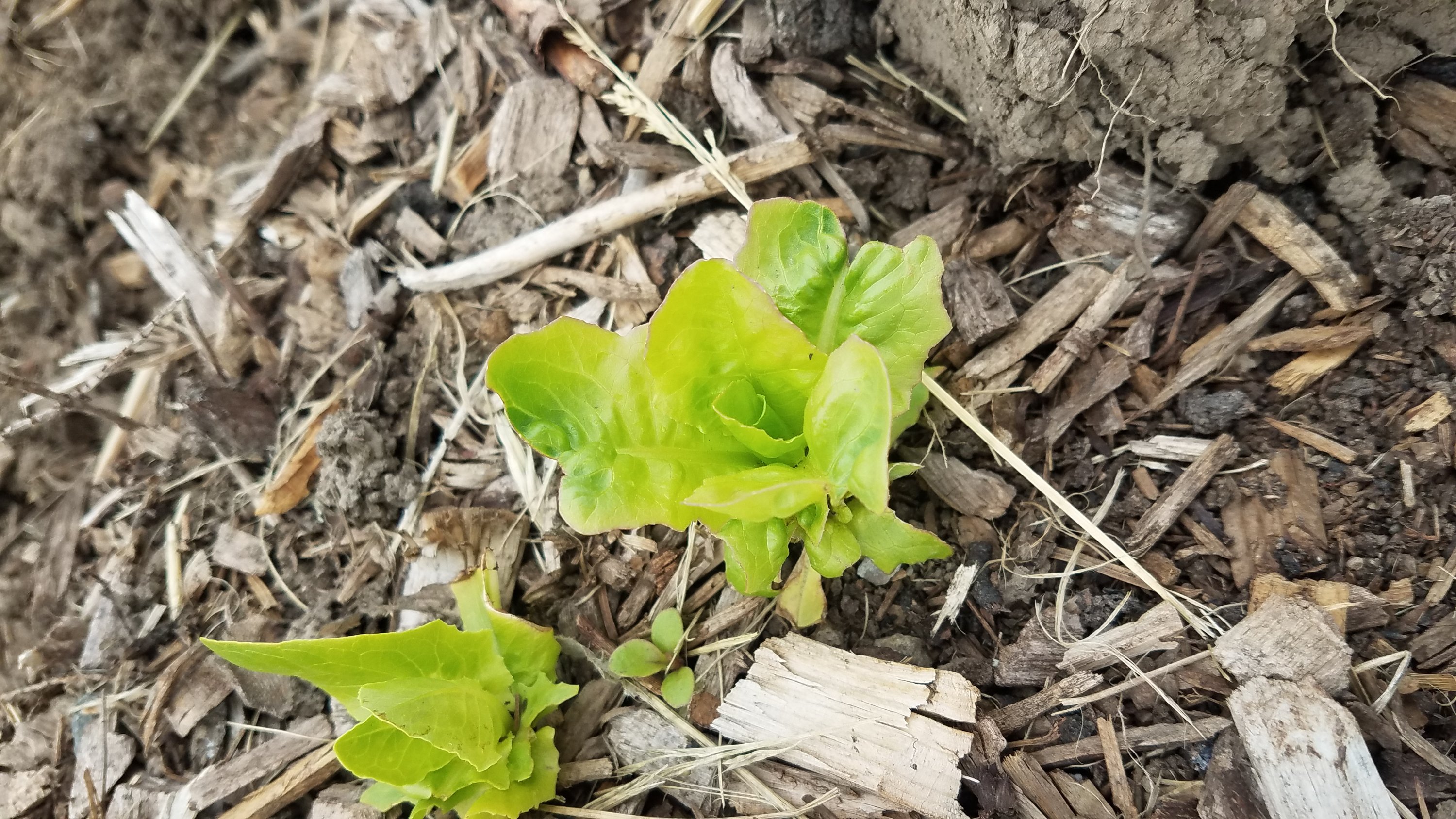
The rabbits didn’t attack this lettuce… Some other midnight snacker did. 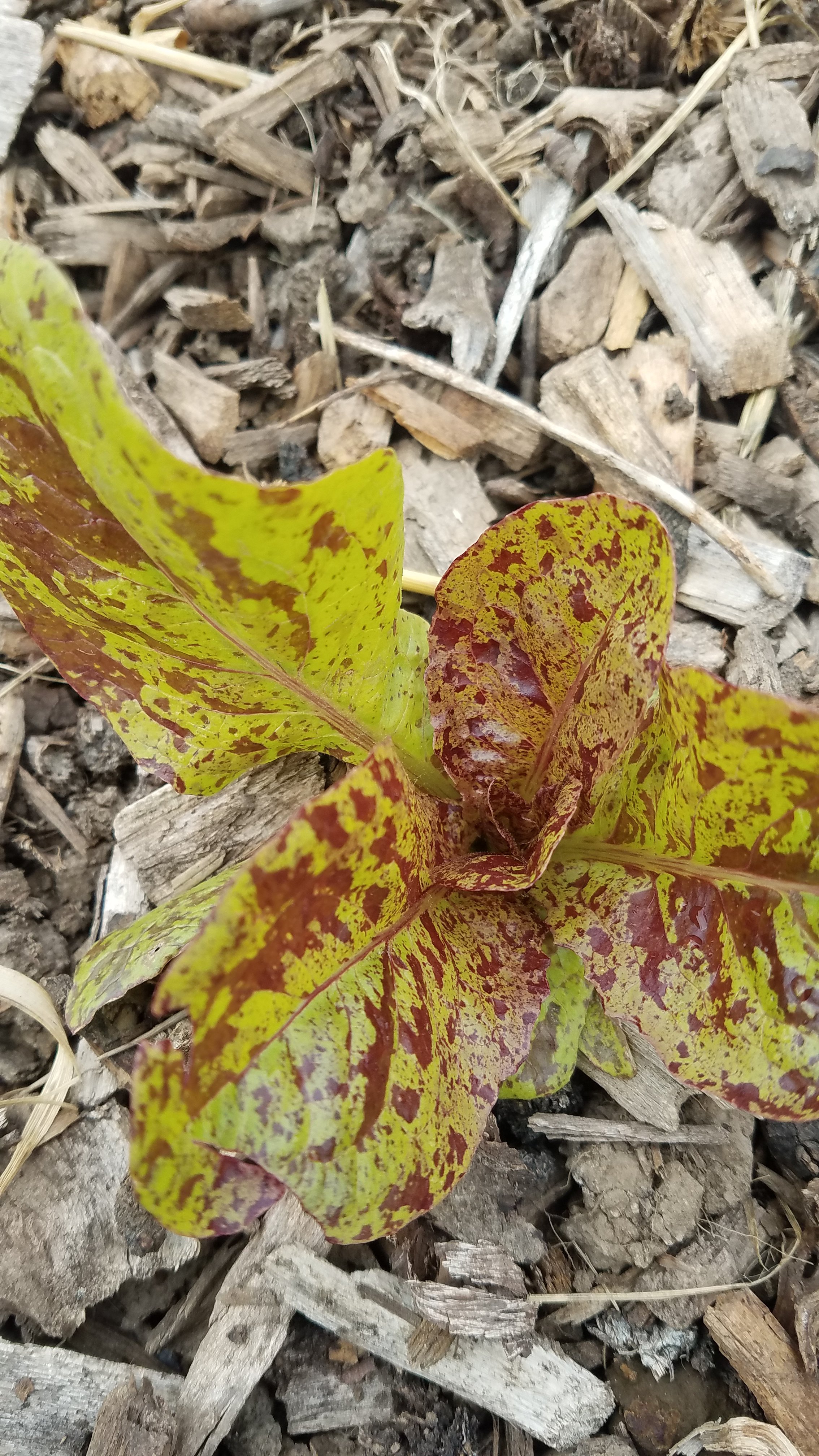
I’m in love with this lettuce. I have no idea what it’s called, but it’s gorgeous. Kinda crime-sceneish, but still lovely. 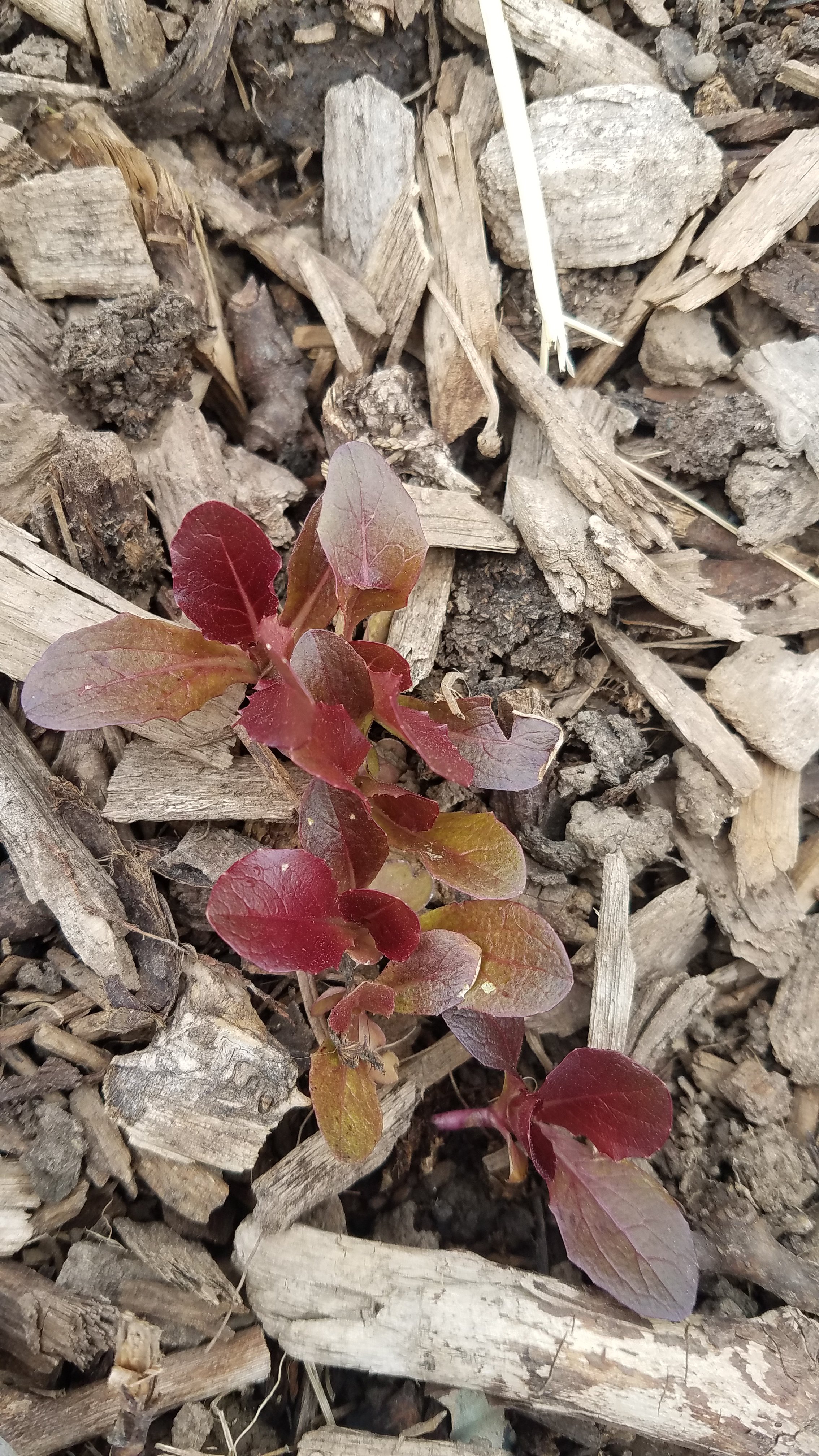
Pardon my french, but I think this Romaine variety is Rouge d’hiver 
Garlic can be harvested when the bottom 3 leaves are wilted. This one was a test garlic that had 2.5 leaves half wilted. I’ll give the rest a couple more weeks. 
Baby eggplant, I will love you and take care of you all summer long because you are SO CUTE! This is actually a baby eggplant plant. Fruit gets 3″ long. 
This is our once-every-decade habanero for Josh. He makes dried habanero flakes that last 10 years 
Teeny baby kale plants! Hurry up and grow!!! We’re very hungry! 
Pretty flower from the side yard. Jack in the Green. Dumb name. 
A flower about to blossom. Maybe a gloriosa daisy? 
More flowers. Flowers are for gifting to people. I only want them in my yard until they’re pretty enough to chop down and put in a mason jar. I wish I had more cutting flowers. My zinnias are about 1/2 inch tall, so maybe this July?
That was a collection of snapshots from the garden today. I forgot to add the pic of my apocalyptic basil garden. Golly, there are probably 50 basil plants (Genovese, mostly) that are going to get me through 6-12 months in a survival bunker with an all you can eat pesto stash. I refuse to fight off zombies if the apocalypse managers feed me a diet of expired Spaghettios and Tang drink mix. I will not comply.
And…I weeded today. I must be getting super old and super boring because weeding is fun! I was always a boring gal, but admitting that I like weeding is truly tragic, just like a Shakespeare play. It’s a tragedy where everyone important dies, but the female heroine is alone in her garden pulling weeds, with a peaceful smile, and singing a song about english roses and fragrant lilacs, then the British army comes in and drags her off the stage. Scene.
Oh pumpkin, my pumpkin.
Last year, we discovered the world of pumpkins. As fast as neighbors dropped off their unwanted autumn decor, we scooped them up, identified them, and saved the seeds. We had a list of pumpkin varieties that we’d never even heard of before!
This year, we shared the seeds with our neighbors, passed some along to family, and saved some seeds for ourselves to plant around the farm.
Here’s what we planted: Marina di Chioggia in the rabbit poop area of the old chicken yard, Mellow Yellow on the northeast corner outside of the pasture, Kakai hull-less at the base of the Jerusalem artichokes, and the Long Island cheese at the base of the raspberries by the old chicken coop.
So so so many pumpkins. Each with a different reason for being here.
Marina di chioggia: flavor, beauty, color (inside and out)
Long Island cheese: keepability, a great storage pumpkin
Kakai Hull-less: the seed flavor, the seed color (green), the uniqueness of the seeds
Mellow Yellow: for the external color of the pumpkin (bright yellow)
The one big thing that surprised me about growing pumpkins was how blazing fast they sprouted. We planted the seeds in little 2×2-inch soil blocks. They sprouted within a matter of days and seemed to double in size each day. Then, when planted, they continue their rapid, accelerated growth. Very inspiring.
Forgot to mention… Today I filled in Josh’s sweet corn row with a few seeds to replace the ones that didn’t germinate. I also planted 30 (2×15) red dent corn seeds. The variety is “bloody butcher”. Eww.
I also rerouted the soaker hose to fill the length of the row that has the squash, eggplant, red dent corn, and greens.
Not sure if I’ve articulated this yet, but I’m very pleased with how our garden is growing this spring. I feel like, with the exception of the peas, we’re ahead in every way. Josh decreased the pH over the winter with sulfur, we put loads of aged horse manure on the entire garden, our plants are getting regular watering through our new watering system that Josh installed, and every plant is looking great, with minor exceptions (you know who you are)!
We’ve already started harvesting the tatsoi and the streaky red and green lettuce. The beets are a few weeks away from being harvested. The herbs are being used every day. The next thing we’re waiting for is the peas. We have gorgeous ruby red strawberries that were using to feed the slugs… And we need to figure that out. How do I get the slugs to not eat my berries??
Soon we’ll be moving the chickens back into the garden to dig up slugs and weeds in the garden paths between the rows.
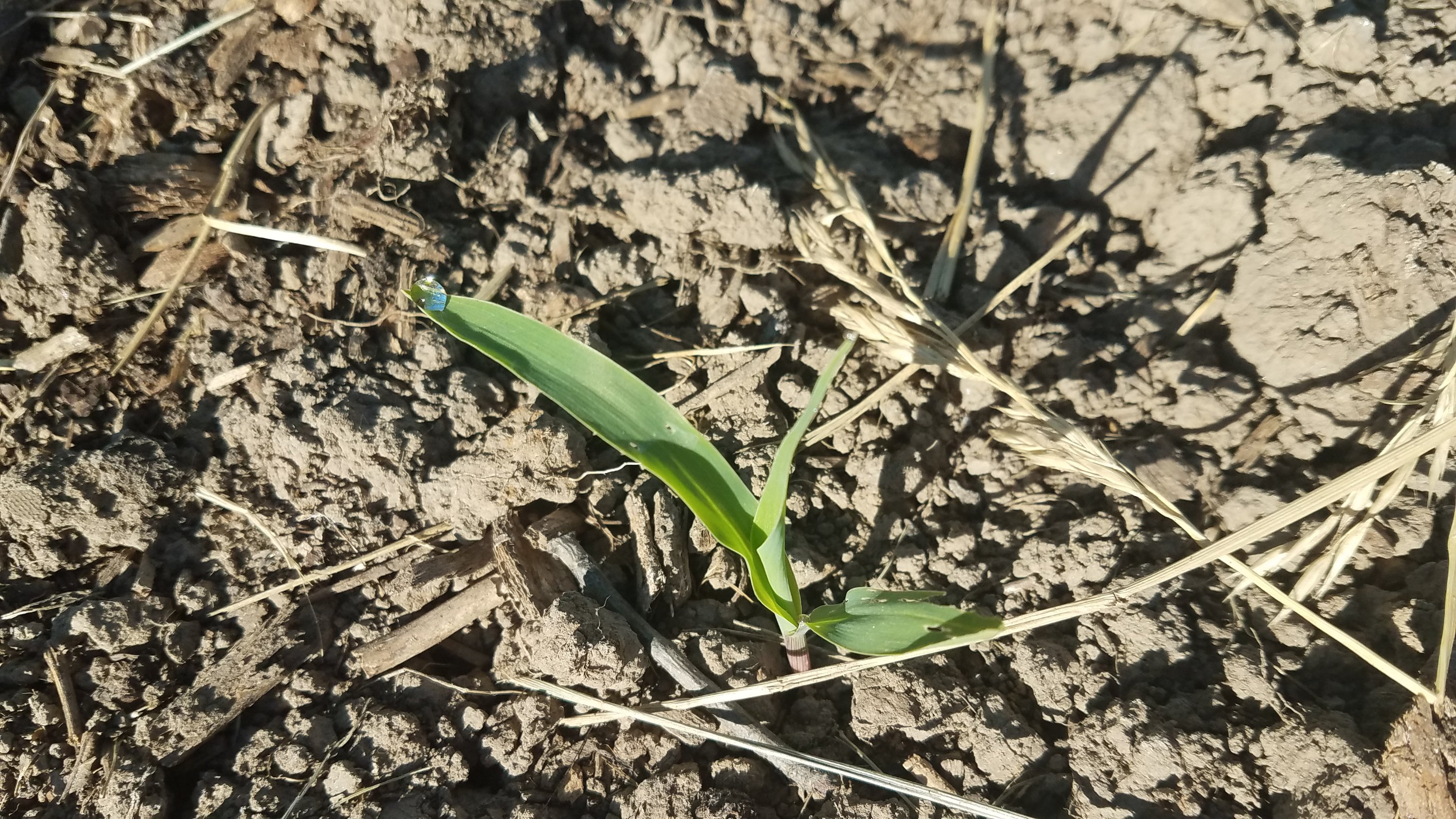
A corn (with a single tear trickling down its cheek) 
The garlics 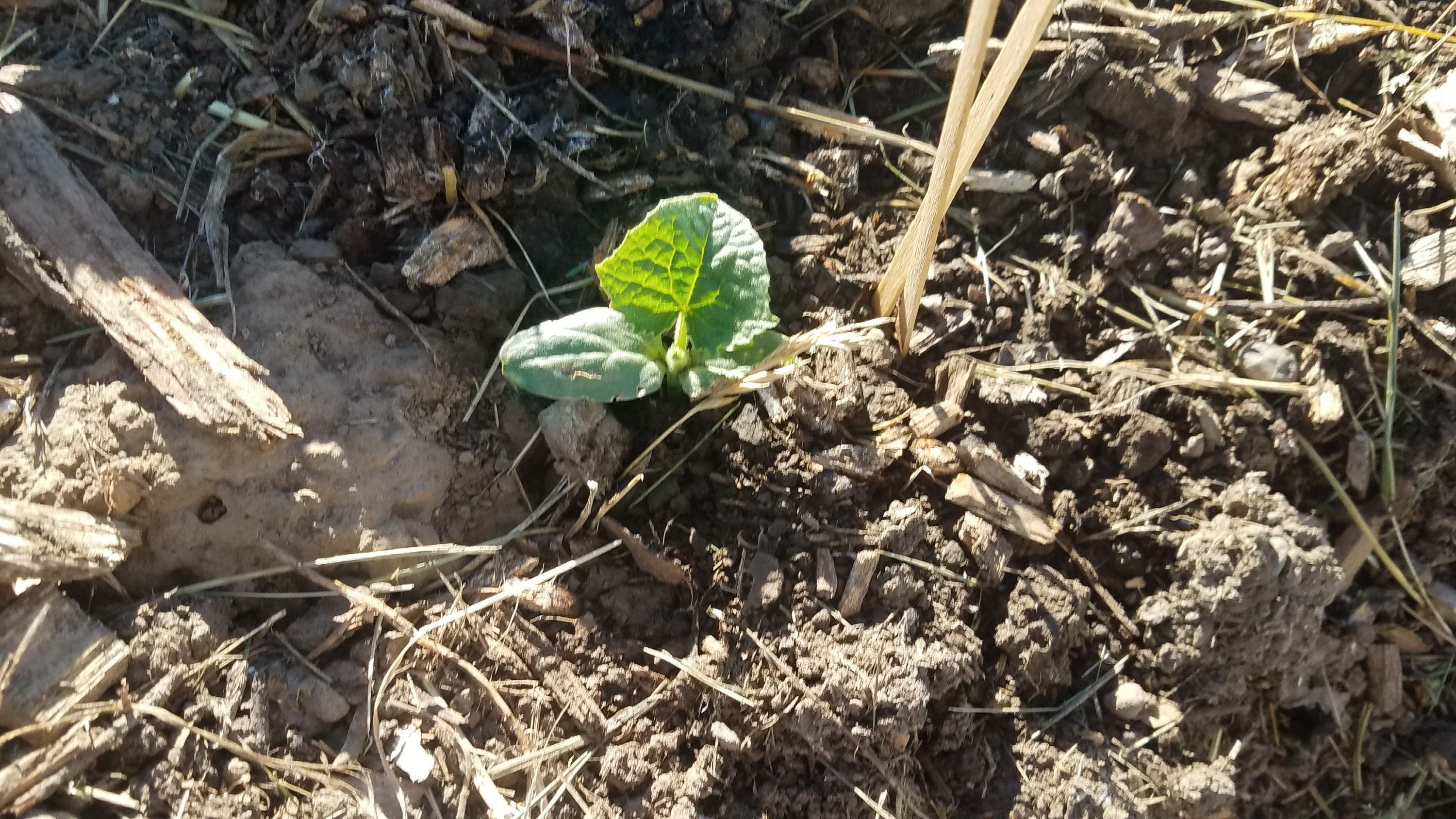
Mr. Cucumber (looking dapper, my friend!) 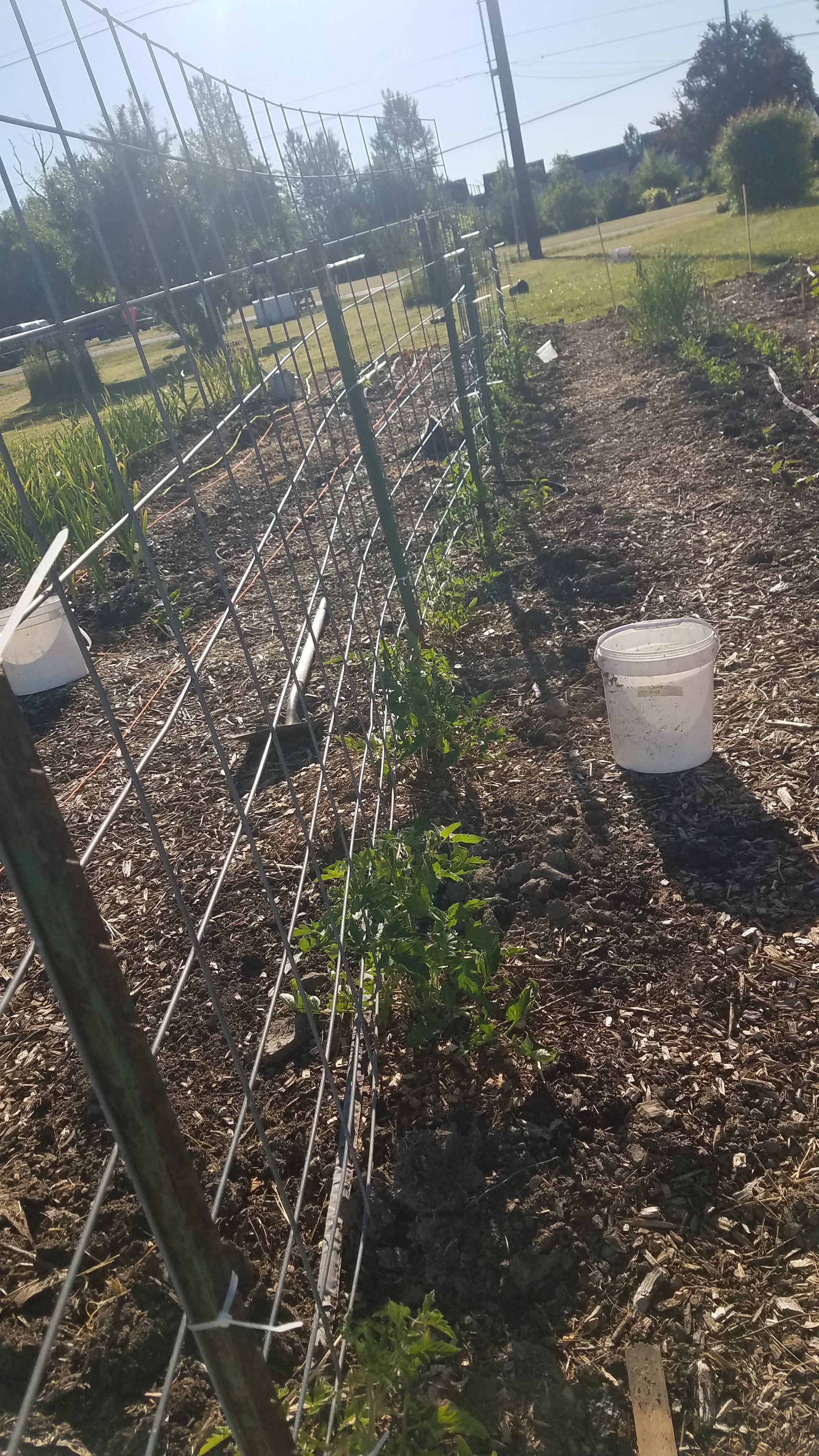
The tomato gang 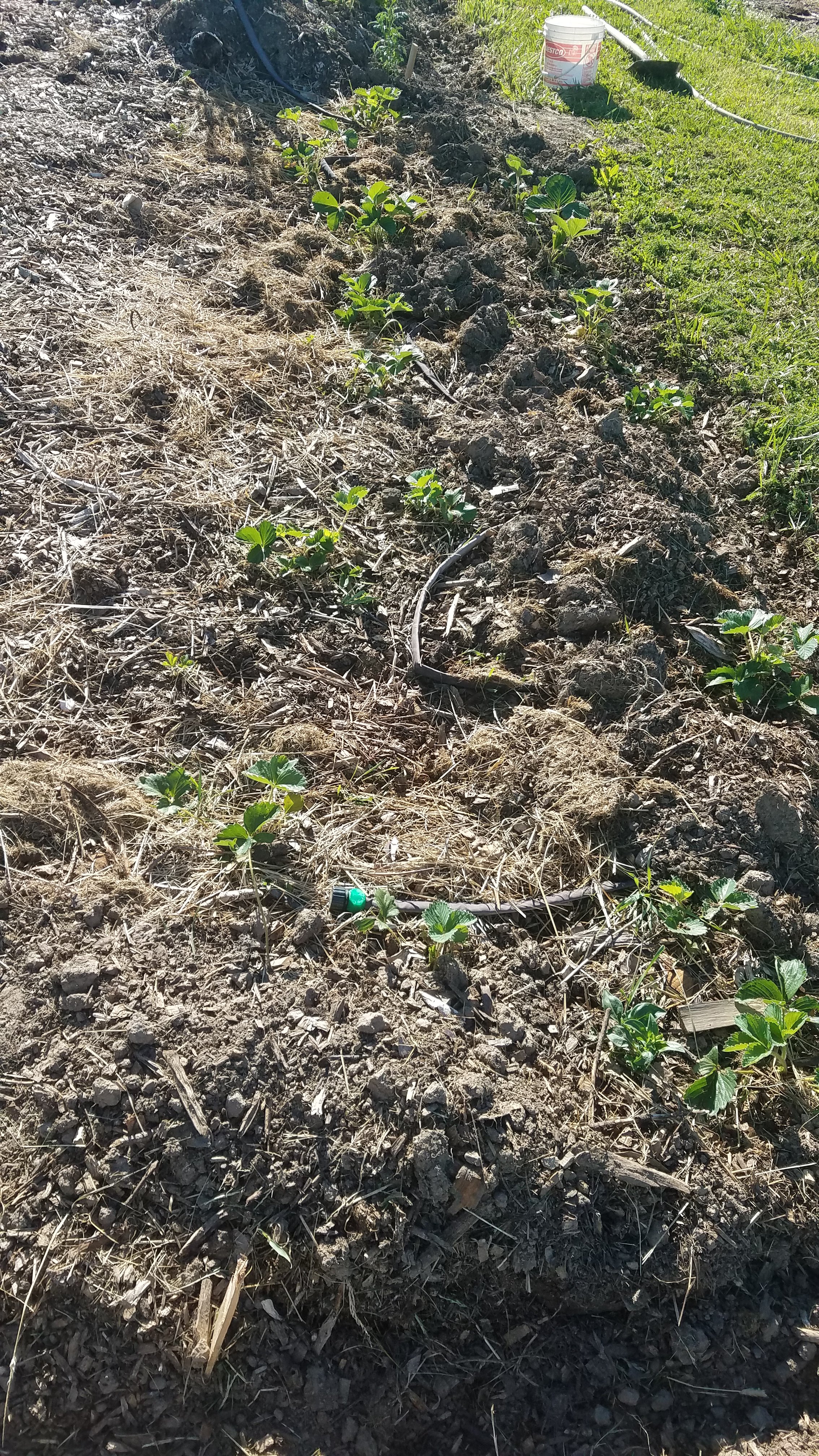
First year of everbearing strawberry plants from our friend Jan 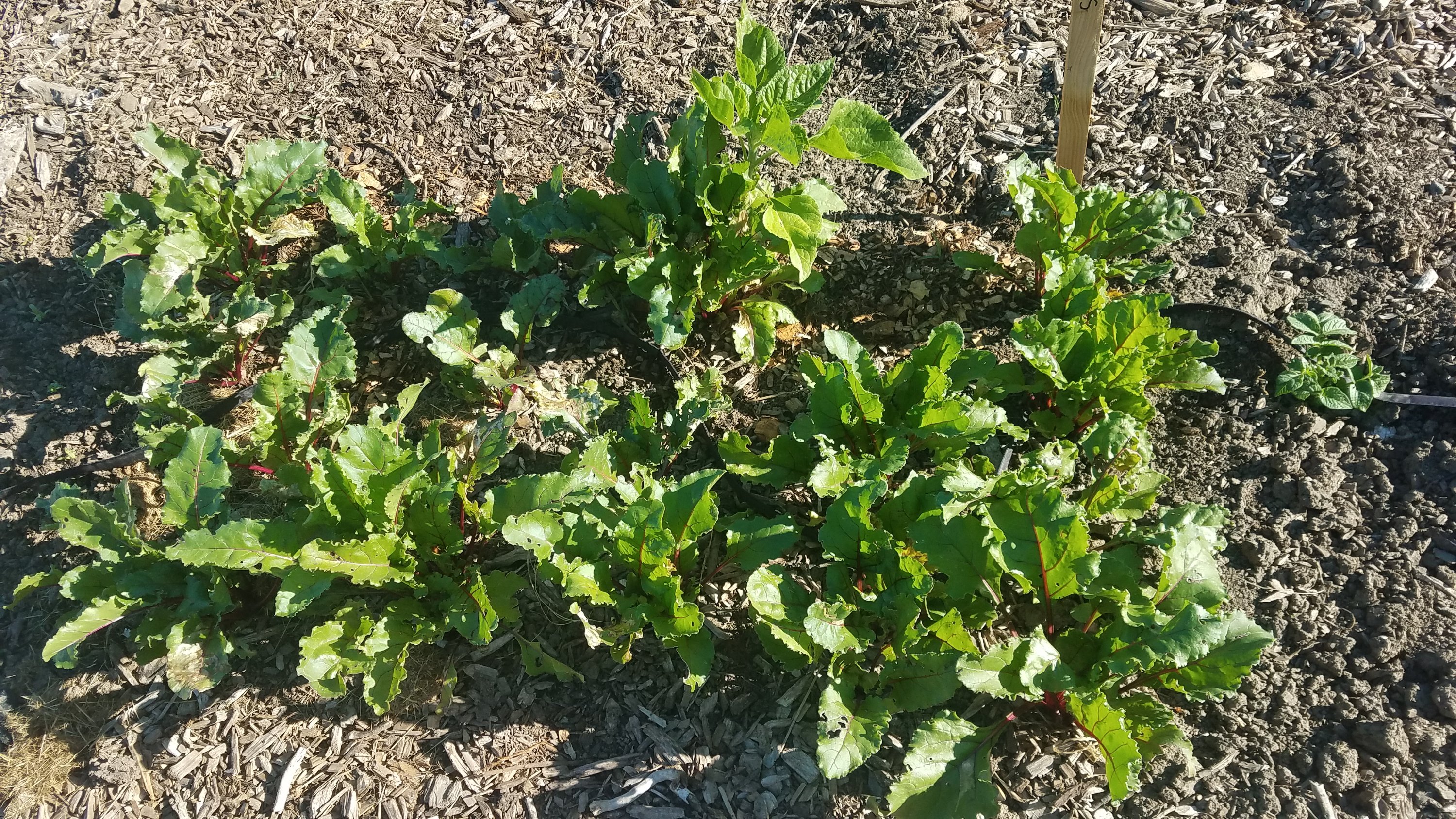
Beets. “Dear beets, you are much easier to grow than carrots. Love, the Garden” 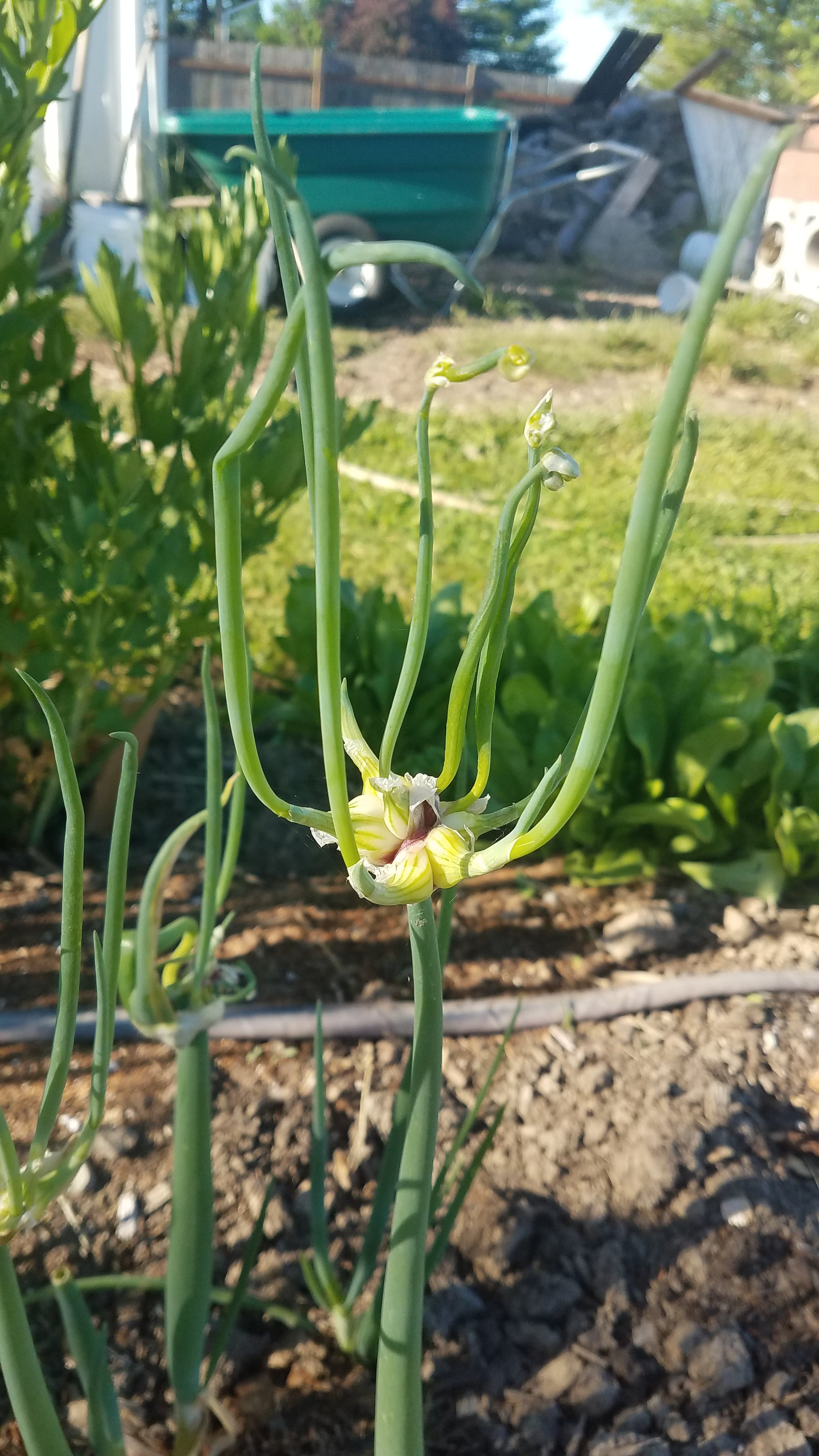
Egyptian walking onions… Part of my goal to have more allium in my garden 
Horehound. She’s part of my new medicinal herb garden. 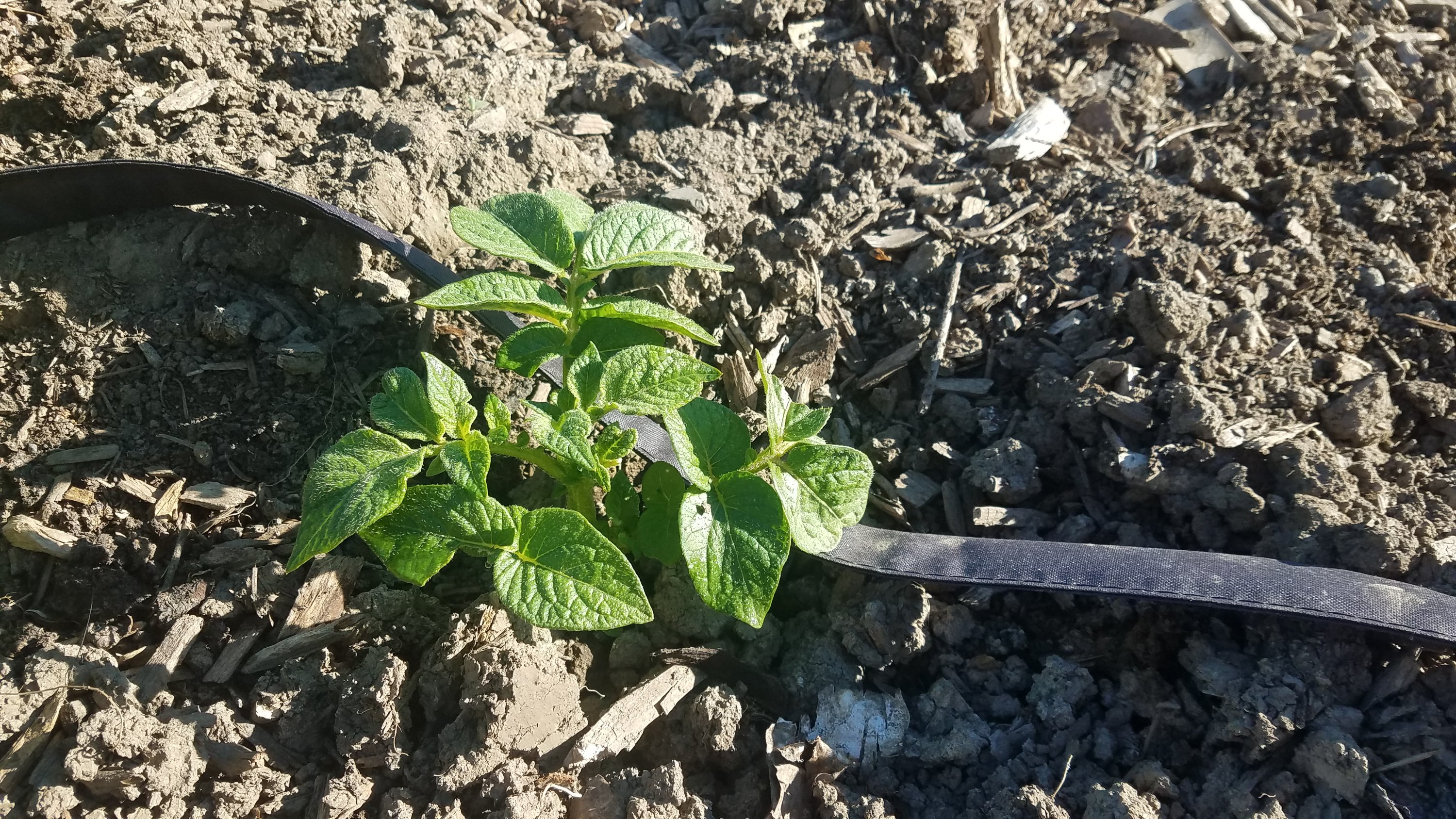
Holy cow! Potato plants really do grow from cut up potatoes!! 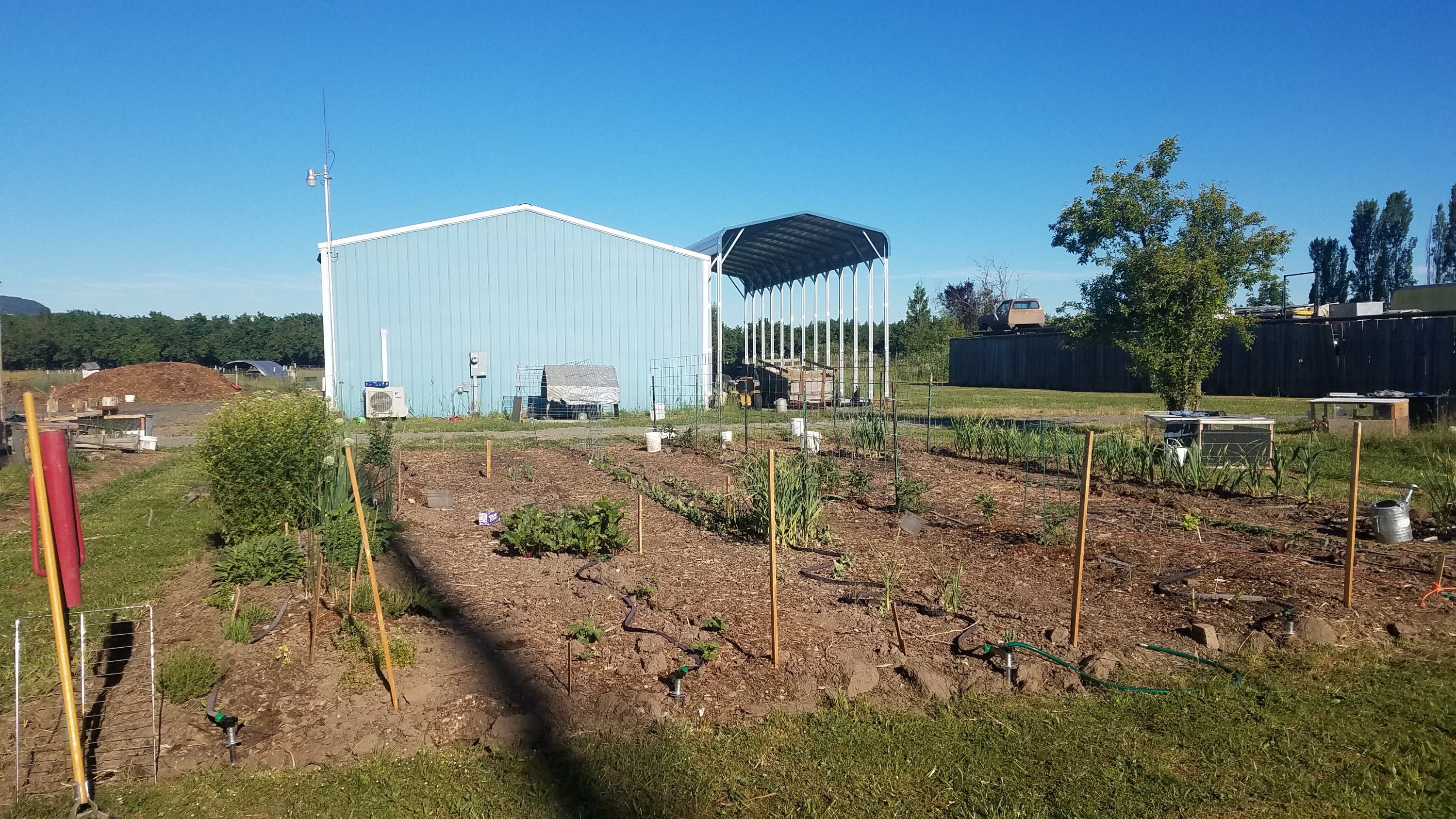
Our garden 
Again, our garden (big bush is chamomile)
Tour de jardine. La di dah.
Sometimes with gardens it’s easy to feel like you’re so far behind. Like “It’s already June 3rd and were not harvesting peas yet!” True–other years we harvested peas around this time, but last year at pea harvesting time we had zero garlic, a culinary herb garden the size of El Salvador (so teeny tiny, very very small, not big at all), and no overwintered greens. This spring has been very good to us, even though we have no peas to show for it. Our garlic all sprouted and grew, I harvested from the culinary herb garden all winter/spring, and we ate kale +chard all winter/spring like it was going out of style (because it is going out of style–orach is kinda the new kale).
We have no fresh peas yet, but it was the weather’s fault. Nothing more boring than hearing people talk about the weather (except for hearing people talk about video games or Avengers movies), so I’ll keep this short. April was supposed to be cool and wet, but it was freakishly hot and dry. So, no little pea fruits yet. Hopefully we’ll have a harvest before Thor’s hammer of heat withers our little pea shoots like spawned lava in Minecraft.
Our Old Mother Stallard beans were lackluster sprouters. Maybe they’ll perform well and be abundant. I moved some Stallard seedlings on the end to be with their friends. To keep our garden full, Josh recommended that I fill the empty spots with asparagus beans. We’re sprouting them in soil blocks this week!
Yesterday Isaac and I spent a couple hours weeding the garden and digging a trench around it to prevent grass from creeping in. I know weeding isn’t a one-and-done thing, but for now the garden looks very tidy.
Most of the weeds were grasses, yarrow, plantain, clover, and volunteers from last year’s garden. We have used free arborist wood chips for the past couple years to reduce weeds–and it works! As long as we keep the woods chips on the surface, they don’t affect the nitrogen level in the soil.
We’re also experimenting this year with amending our soil with home grown rabbit manure. It isn’t a strong fertilizer, but it’s also safe to use without “aging” or composting.
In years past I (Heather) haven’t contributed much to maintaining the garden. But, as I’ve said before, the food shortages and disrupted supply chain of 2020 and 2021 have motivated me to be a more active participant in my literal survival. We’re slowly replacing things we used to buy at the store with home grown items.
Also, everything about growing your own food is good. It’s seasonal, organic, ultra-local, fresh, produced with natural fertilizers, and it just feels nice to watch something grow that started as a little seed.
Update: Apparently the dirt I dug from the trench landed on Josh’s freshly planted row of corn.
The first row of corn is up, and I planted the second row today. The potatoes are up, too. Instead of thinning the tatsoi, I tried transplanting every other plant to give them enough space. We’ll see how they handle it.
With the tractor running again, I was finally able to do some grooming on the driveway (I had to wait for rain, too, to loosen things up and keep the dust down). While I was using the tractor, it suddenly died. It turned out to be a buildup of deposit on the rotor in the distributor. A little sandpaper took care of it.
I forgot to mention, the bees died over the winter (probably from mites). Alden got a new nuc a couple weeks ago. Yesterday, he added a second brood box and two supers back onto the stack. We hope we can figure out how to help the bees survive the winter. We sprayed for mites last year, but apparently it wasn’t effective.
Seeds are miraculous. They lie dormant…then under the right conditions (playing “You’re the Inspiration” by Chicago helps) they emerge from their growing medium.
The above pic is one of my trays of soil-blocked pumpkin seeds. I also have trays outside that are filled with beets, zinnias, basil, and carrots.
I wish more people grew gardens, but I’ll save those musings for another post…
I grow herbs because they make me happy. They are typically robust, fragrant, beneficial and evergreen. Herbs are my spirit animal.
My favorite way to use herbs is to go into the garden, harvest the herbs that look healthy, place them in my herb basket, then think about how to use them as I clean and mince them.
“Hi, I’m Heather’s herb basket!” (Ignore the grumpy old rutabaga on the right.)
Y’all, it’s May 20th. We’re nearly a month past the “last frost date” but we got frost last night. That ain’t right! Thank goodness we were able to use the last of the evening light last night to quickly cover our tomatoes, basil and peppers with old frosting buckets and quart mason jars. We also brought in all of our tender seedlings.
This little cold snap is great for our peas, lettuce, mizuna (if it ever sprouts), orach, and cutting mix. We’ve had a month of no rain and lots of 80 degree days. That’s not the kind of weather that cold weather crops thrive in. However it is the kind of weather that makes you confident that the last frost is nearly a month in the rear view mirror.
Yesterday I was shopping for a thermometer/hygrometer for Isaac to take on his mission (it was on the packing list). Many of them had happy/sad face to indicate whether the humidity and temperature were in a comfort zone. I don’t like the idea of weather determining my mood. I’d like to think that I choose my mood regardless of the temperature or humidity.
However, if erratic weather starts messing with my plants, I think I’m allowed to get a little ruffled. How is it that we can have such a strong seasonal pattern of winter, spring, summer, fall, but the individual days can be so uncharacteristic of the season they are supposed to belong to?? (And don’t say “climate crisis.” It was a rhetorical question.)
I’ve made a lot of purchases over the years that I thought would improve my life, but they didn’t. Silly kitchen gadgets, ridiculous beauty products, and outdoor gear that is languishing in a dusty storage tote. It’s rare to find a product that promises AND delivers, then becomes an heirloom worth passing down to the next gen.
I bought two soil blockers this month, and already they have earned a top ten spot in my life (and in my heart–not even kidding). Anything that makes gardening easier, more productive, more economical and more effective is the kind of thing gardeners dream of.
A soil blocker is a little hand tool that you pack a soil blend into, then pop it out into perfect little squares–kind of like an ice cube tray, but the soil blocker has an ejector. Then you take the block of soil and plant your individual seeds (or multisow modules, thank you Charles Dowding) into the little squares of densely packed soil.
The soil blocker has dimples in each block which indent the top of the soil block, to make for easier planting. Por ejemplo, my 2×2 inch soil blocker has interchangeable dimples to accomodate large seeds, small seeds and a 3/4″ square so I can transplant my little soil blocks into bigger soil blocks.
You can’t just use garden dirt to make soil blocks–you have to use something that will hold more water and not get too hard. You have to make a special blend for your soil blocker. There are lots of soil blocker soil recipes, but I like to keep it simple: scoop of peat moss + a scoop of potting soil. Add enough water so that when you squeeze it into a lump in your fist, it sticks together. Oh, and as you’re mixing, pull out any big chunks of sticks or bark. (At the time of writing, peat moss is $11 for a bag so big that I can barely carry it).
I hand pack my soil blocker cells. I push the soil mix in pretty tight so that the soil block sticks together as the seedling grows. Then I squeeze the handle and out pop perfect squares of soil, ready to be seeded.
There are so many benefits to creating your own soil blocks. No plastic containers (yay!), no transplant shock when planting your seedlings in the garden, better use of space, easy, relaxing to create soil blocks, and it’s very beautiful. Leave room in the tray where you put the soil blocks so that you can water from the bottom. (They’ll disintegrate if you water from the top.)
In conclusion, a soil blocker is a really nice garden tool and I think evvvvveryone should have one. The End.
